AVANI SUMMER WORKSHOPS

MetaPlay 1.0




Design Efficacies, Exploring Openings Architecture of the Yesteryear
HISTORY, THEORY AND CRITICISM : SITE VISITS
Exploring the Regional Temple Architecture of Kozhikode, Kerala
Exploring the Regional Mosques of Kozhikode, Kerala Tales of Trivandrum
Exploring Self through Material Media
RSP
The Architecture of Kallayi's Industrial Architecture Understanding the Architecture of Michabhoomi, Thamarassery
EVENTS
Learning Together
A Visit to Avani Community Ameyam 2022 Campus Furniture To be Heard.
Embracing Culture Capturing Context On the same page.
Campus Bird Count Museum in the Making
#03 | DECEMBER 2022
ACHIEVEMENTS

Ar Vinod Cyriac, Ar Nimisha Hakkim Ar Vivek PP, Ar Nishan M, Ar Anitha Choudhuri Ar Vishnu K, Ar Krishna Salim Ar William George Kennedy ,Ar Ujjayanth Bhattacharya
STUDENT ACHIEVEMENTS
Alan George Joseph, Iman Hashim, Fathima Shanna, Sneha Nour, Aiswarya Vijay, Ananya AP, Aneez Mohammed, Janet Bridget Joyson Renna Fathima, Mohammed Nihal Kuruppamthodi, Hiba K, Ayisha Shadha, Reesha Faizal Mary Ann Mathew, Ahay MJ, Minu Joseph, Wafa Abdul Rahman,
STUDENT ACTIVITIES
Iftar Party Going beyond the Hour Tadbhava Embracing the Colors
EDITORIAL NOTE
Moving Forward
Seven years old and AVANI is spreading roots and tender branches, seeing a different light. Our first and second batches of students graduated in 2020 and 2021, realizing the fruits of their efforts-hopefully idealistic and yet grounded. If one has to weigh, we know that the past two years have made us resilient and aware of the inequities that challenge us as a society. Unknowingly, amongst us there have been some silently in remorse. We remember Alphin Rodriques (Batch 2018), a congenial young man whose journey was short.
Involvement to redefine, pave and improve the path for an equitable tomorrow, creatively, becomes imperative for our students, mentors and us as a commune. We have been fortunate to have a myriad of resource persons who have interacted with us at varied levels of architecture, urbanism, aesthetics, philosophy and art.
It is here at SEGMENTS our newsletter that we can engage, voice our aspirations, commit ourselves to activism through architecture as a collective.
Written by: Ar Vinod Cyriac Governing Council Member
WORKSHOPS
MetaPlay 1.0
Global Design Workshop: Designing Future Virtual Playscapes
Collaborative Design Workshop FOV, Bangalore
Avani Institute of Design in collaboration with Design Future Foundation (DFF), USA and DEZACT, London is curating ‘MetaPlay’ a design workshop series which investigates design of future social and leisure experience in virtual environment and extend the scope of research exploring time as a dimension with a focus on spatial transformability and programmable matters. Metaplay 1.0 explores the potential of using emerging technologies such as parametric design, modeling and Augmented Reality (AR) / Virtual Reality (VR) tools to explore and rethink built environment design using digital media.
the opportunity to learn and collaboratively apply these skills to design and build architectural scale projects within a virtual environment. Since the pandemic, Avani’s architectural studio pedagogy has made a focused attempt to use the challenges of the pandemic as an opportunity to explore the potential of virtual platforms such as Game/VR/AR for architecture and design.
This six-day workshop conducted over three weekends operated as a micro design studio imparting hands-on digital and parametric modeling skills as well as skills in using cutting-edge interactive UNREAL engine within the AEC industry. The workshop provided the student community a hands-on exposure to digital visualization and immersive experience creation for architectural spaces in AR and VR, and a practical guide to endto-end workflow from conception to production through digital technologies. Participants had
Over these two years a dedicated design studio led by Dr. Soumini Raja, Ar. Vineeth T K, Ar. Athira Balakrishnan and Ar. Mithun Basil systematically investigated and contributed to the discourse on architecture’s role in the Metaverse. The workshop, is an offshoot of the studio pedagogy, brings together Avani, DFF, and DEZACT to further this exploration, aiming to understand parametric design tools and processes.
Virtual worlds such as Decentraland and Sandbox have seen a flurry of activity and Metaverse has emerged as an disruptive technological trend slated to transform our societal futures by impacting the way we live, work and play. Over the next decade, people will seek more and more immersive virtual


01
01
experiences, pushing consumers and brands into the Metaverse. In such a scenario, the MetaPlay course expects to trigger a game-changing enabling experience for the virtual designers and developers of this future. The Metaplay 1.0 teaching team included instructors and tutors from leading global design and architecture institutions such as the Architectural Association, Bartlett UCL and others. The list of the instructors includes names like Akshay Goyal (Founder of Tron Labs and Partner at Architron Group), Ping-Hsiang Chen (Senior Architect at Zaha Hadid Architects), Vineeth T K (Educator at Avani Institute of Design), Cherylene M. Shangpliang (Designer at Zaha Hadid Architects, London), Zehao Qin (Design Systems Analyst in Applied Research Development (ARD) group at Foster Partners, London). The final jury and exhibition work occured on the concluding day and consisted of experts like Mayur Mistry, Saenawee Chatameteewong and Amit Gupta.
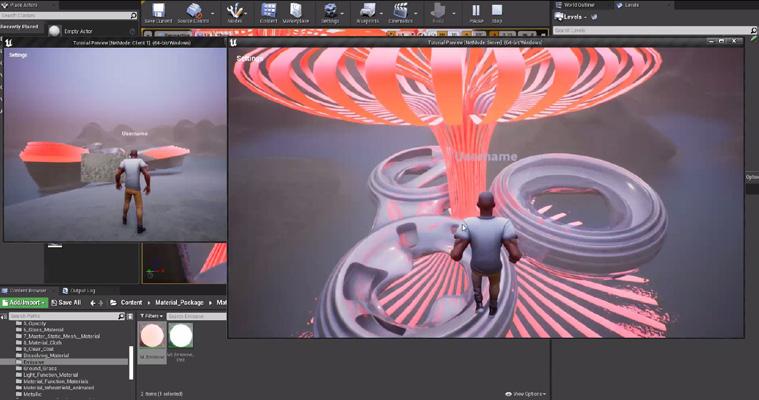

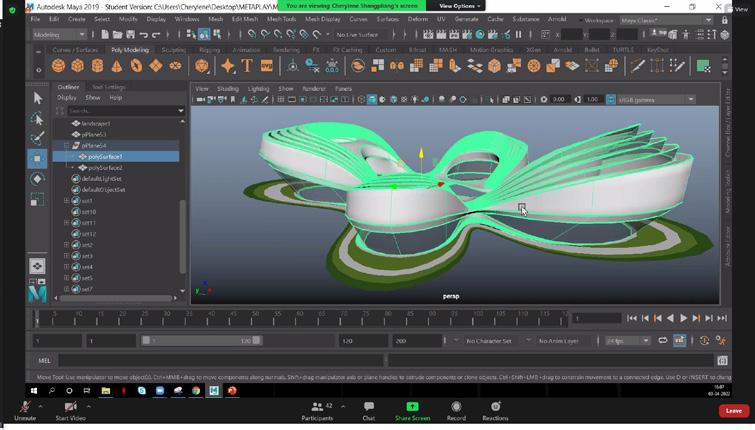 Written by: Ar Vineeth T K
Written by: Ar Vineeth T K

02
Design Efficacies, Exploring Openings
Agents of allusion through model making
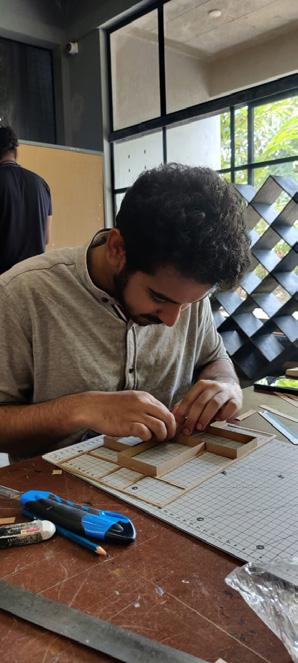


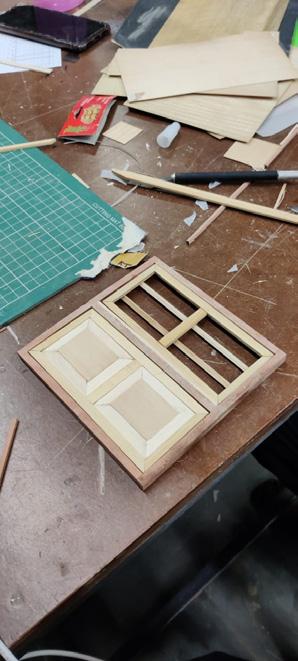
The increasing ease with which computer technology can be utilized nowadays results in students avoiding the use of physical models, favoring threedimensional computer models. However, this process is devoid of an intense and much needed cognitive experience that is attributed to only physical model making. Models can also act as exploratory devices by working as self-communication tools and allowing new questions to be raised, alternative solutions to be explored, hypotheses to be formulated. Prompted by an articulation of imaginations/ experiences / perceptions / interpretations associated with the elements of space definition - doors and windows; warranted by instances from literature and/or movies, the workshop structure intents to build a premise involving the elements, analyze the attributes, identify the variables, design alternatives or study and replicate the existing, produce physical evidences of the informed architectural study using model prototypes. Exercising a cognitive exploration of the scholarship on learning by making, the workshop intends to instigate an approach that values active self-reflection and informed architectural ideas by developing the hand crafting/model making and representational skills of the students.
Written by: Ar Sebastian Joseph
02 03
Architecture of the Yesteryear
Documenting a Traditional Residence Typology from the 1900s Malabar
students visited Avolam ‘theru’ sitting 1km North of Nadapuram panchayat in Vadakara, Kerala, and conducted a 03 days on-site and 02 days on-campus documentation.
The 03 days on-site workshop enabled students with firsthand experience of the archetype from the frontyard to the attic. Students were shown and explained the techniques of construction as well as the scenarios that lead to the development of this traditional building style.
On the first day, students went around seeing different houses that were developed around the premise of the archetype under study. The street walk and sketching exercise along with resident interaction that followed were insightful in setting the introduction to the context. Starting from day one, the students phased out the documentation through the 03 on-site days.
The workshop titled ‘Architecture of the Yesteryear’, Documenting a Traditional Residence Typology of 1900s Malabar’ was an invoking documentation workshop conducted by Ar Athira Balakrishnan and Ar Sanjay as part of the first Avani Workshop Series for the Monsoon 2022 semester.
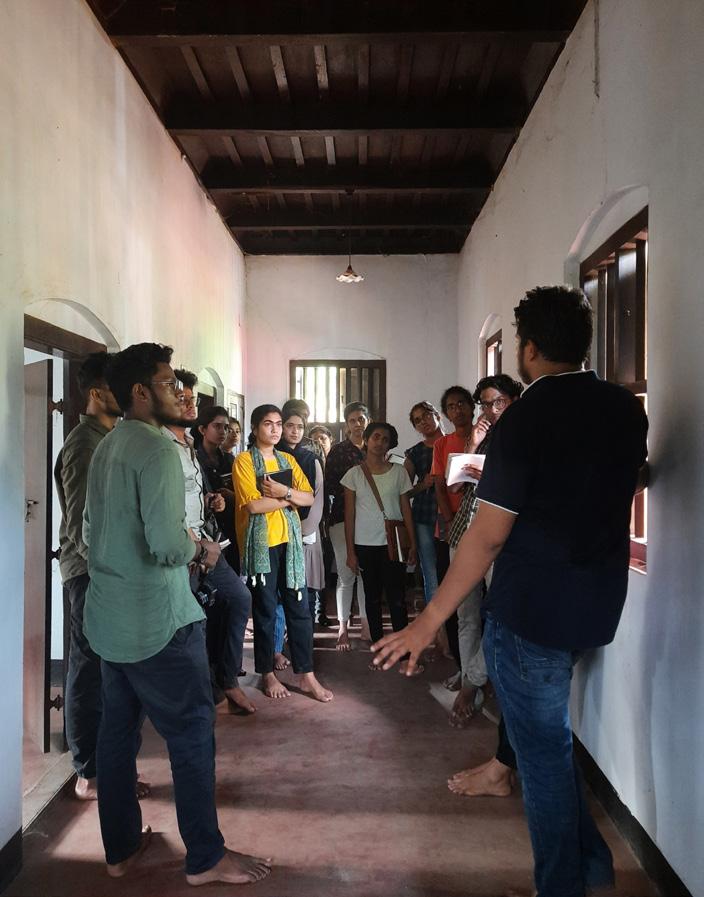
The workshop was an effort at understanding the contemporary of the ‘not so distant’ past of Malabar, which hasn’t found its way into the books on traditional Kerala architecture. A group of 15
On the third day, a local resource person shared exclusive knowledge of Vaastu traditions and the perspectives that architects of the era carried as they visualized such buildings. The workshop was further extended to the campus for two days wherein the students were given insight on representation techniques to develop the documentation further. The workshop publication aims to bring in critical analysis of the 1900’s architectural landscape to that of now, and hence identify key agents of adaptation in architecture.
 Written by: Ar Athira Balakrishnan, Ar Sanjay Veerakumar
Written by: Ar Athira Balakrishnan, Ar Sanjay Veerakumar
03 04
SITE VISITS
HISTORY, THEORY AND CRITICISM
Exploring the Regional Temple Architecture of Kozhikode, Kerala
Semester I and II
Temple, according to the Oxford dictionary, is the edifice or place devoted to divine worship. Various religions call it differently. Most of the Indian temples are not only places of worship, but also centers of excellence in art, architecture, and culture. The first-year History of Architecture starts with the prehistoric developments in the world and then in India. The second half of the syllabus focuses on the Hindu temple architecture of India, including Dravidian and Indo-Aryan styles.
Even though the Kerala temples are unique in its planning, architecture, and management, it is surprising that this particular portion is not included in the syllabus. In order to fill this gap, a module on temples of Kerala has been introduced and presented in two parts, a lecture and a field trip. A lecture on the introduction to temples of Kerala was delivered to the students leading the field trip in which the students visited two temples - Thrikkaippatta Subrahmanya temple, Palazhi and Thali Mahadeva temple, Kozhikode.
The first one situated close to Kozhikode Cyber Park was a reconstruction site since 2009. This reconstruction follows strict traditional methods of construction based on the remnants found on
the site.
Students were able to gain knowledge on the basics of the architecture and planning of temples of Kerala and they explored the temples through the lens of history, building materials, construction techniques, planning aspects, traditional knowledge system, and decorative
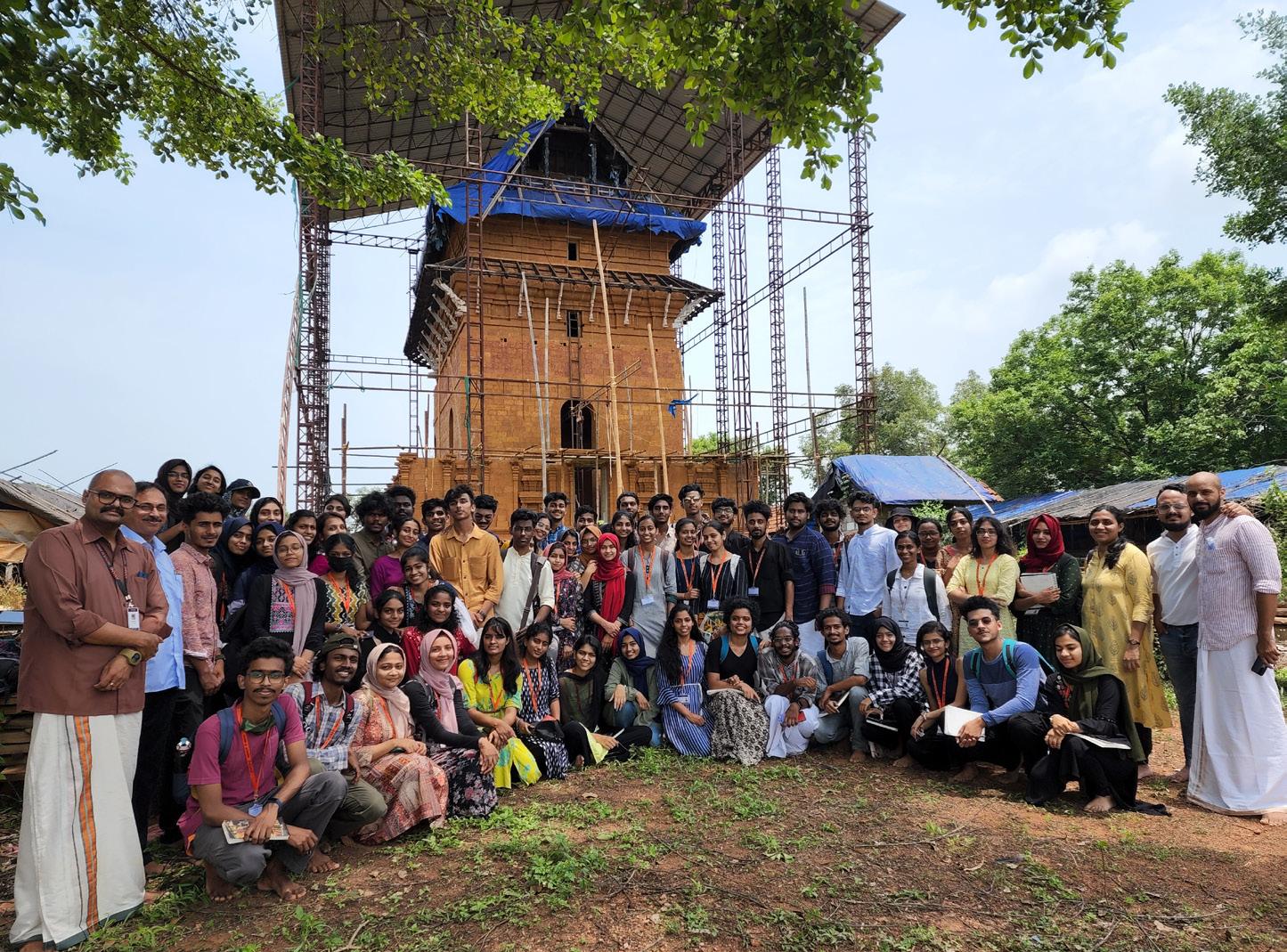
elements.
The second site is a 14th-century temple and is one of the best examples of a temple complex in the Malabar region. Er. Jyothish Patteri, who leads the construction of Thrikkaipetta temple, delivered an on-site lecture on the reconstruction process.
Written by : Ar Devakumar T
01 05
Ex ploring the Regional Mosques of Kozhikode, Kerala

Semester III
The subject HOA III addresses Islamic architecture and its influence on India’s regional history of architecture. The subject exposes students to the various provinces and their architecture in India. Although Kerala does not fall under any provincial styles, the art, culture, and architecture of Islam in the state have significance to regional architecture and holds peculiar nature.


Some handpicked outputs from the individual research and exploration of the regional mosques :
1) Reem Abdhullah
Written by : Ar Devakumar T
06
As the history of Islam in Kerala is often neglected in the History of Architecture syllabus, a new module on mosques of Kerala was introduced. The module was handled with expert lectures, streamlined assignments and site visits to prominent regional mosques of Kozhikode: Mishkal Mosque, Jamath Mosque and Kondoty Qubah. 02
2) Mary Ann Mathew
Tales of Trivandrum
A Walk through the Glorious Pages of Built History
As an initiative of the History Theory Criticism domain, a two day field trip was organized to Thiruvananthapuram with the third year students of Avani Institute of Design. The ongoing theme of the HTC cell emphasizes on regional building and cultural practices, thus extending the vision to the Semester VI History of Architecture module dealing with Indian Modern Architecture. The field trip was organized and curated by domain tutors Ar Gisny George Kurien and Ar Meenakshi Dubey with the supporting team of Ar Monisha V Kunjumon, Ar Rajiv Babu and Ar Ujjayant Bhattacharyya.
The trip aimed to visit and study the regionalist and modernist camps of architectural practitioners in Thiruvananthapuram, Kerala, namely the British Gandhian architect Laurie Baker versus the influential modernists of post independence India J C Alexander, Thomas Panicker, A K Jayachandran etc. The students visited the Laurie Baker Center of Habitat studies, SEVA and Loyola Chapel on day one and day two constituted a heritage walk led and curated by Ar Thomas Oommen. Ar Thomas Oommen, from Thiruvananthapuram, Kerala is an architect, urbanist and historian, currently a PhD Scholar at UC Berkeley California, who researched and published scholarly works on Indian modernity .
The heritage walk began at the PMG Junction and covered Kerala Students Union Building (KSUB), Hotel Mascot, G V Raja Sports Stadium Pavilion, Postmaster General Office, Kerala University Senate Building and the other landmark buildings, with the lens of colonial modernity in the 1970’s at the state capital.


03 07
Written by : Ar Meenakshi Dubey
Exploring the Material Media
Hands-on Workshops for Foundation Studio 2021 - 2022
Textile and Self
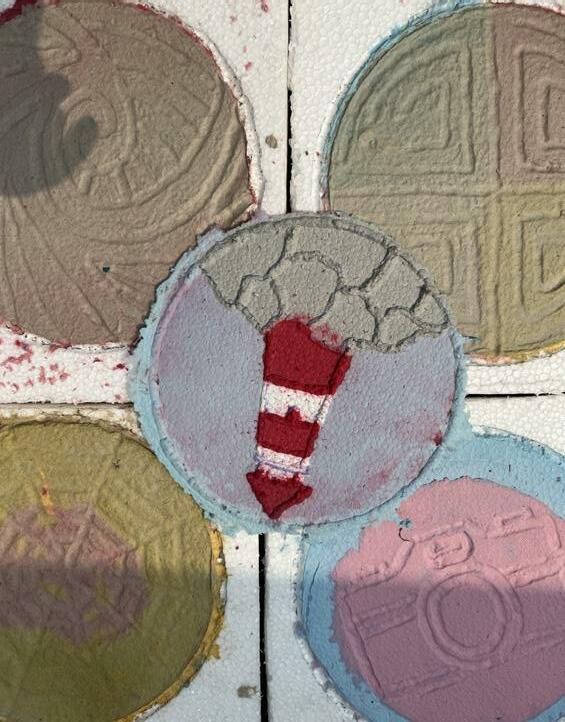
A three day hands-on workshop titled Textile and Self, a carefully curated studio exercise to enable the first year students to engage and immerse into the medium of fabric as a medium of expression which happened on the dates 08th, 09th and 10th of February 2022. Artist Narendra Raghunath, an artist and art educator who has vast experience as a designer, and has taught art and design at IGNOU, NID and NSID. Currently, he is working at Srishti Manipal Institute of Arts, Design and Technology, Bengaluru.

Paper Tectonics
Paper is one of the most ubiquitous substances existing since time immemorial. In its very basic meaning, it signifies the cycle of life. During this four day workshop, the first year students learnt the process of making paper from plant fiber and waste paper along with surface designing and sculptural techniques. Anupam Chakraborty is an artist, papermaker and educator who lives and works in Kolkata. Being an alumnus of Kala Bhavana, Santiniketan, Faculty of Fine Arts, M S University of Baroda and Glasgow School of Art, UK, and also the receiver of many prestigious awards including Charles Wallace India Trust, UK, Senior Research Fellowship, Junior Research Fellowship, and National Scholarship from the Government of India. He is the founder and creative director of Nirupama Academy of Handmade Paper, Kolkata.

04 08
Morphologies of Living


First year students worked with clay in this 03 days workshop to understand the spatialities of natural habitats. The volumetric and planar nature of their interpretations were then used to generate tectonic drawings across several planes to understand plans and sections, under the guidance of the inhouse artist Usman Pakkath and the Foundation Studio team.
Maneuvering Wood
Maneuvering wood, a 02 days woodworking workshop, was conducted on 02nd and 03rd March 2022 for the first year students as part of an exploration into new materials and techniques. Under the able and patient guidance of Mr Manoj Kumar and team, the students used their full rigor in creating joinery, carvings and simple sculptures. Indeed an incredible experience for our young minds. Mr Manoj Kumar K G comes from a generation of wood workers and has been with Avani family for many years. ‘Manoj Chettan’ as he is lovingly called actively engages with the students of the institution, wholeheartedly helping out with their architectural study requirement from time to time.

09
Self Expression of Context : Second Skin
The Second Skin, a wearable design workshop, coordinated by Dr Soumini Raja and Ar Devakumar T, was conducted for the first year students on 04th March 2022 as part of the studio exercise Self Expression of Context and Regional Anthropometry.
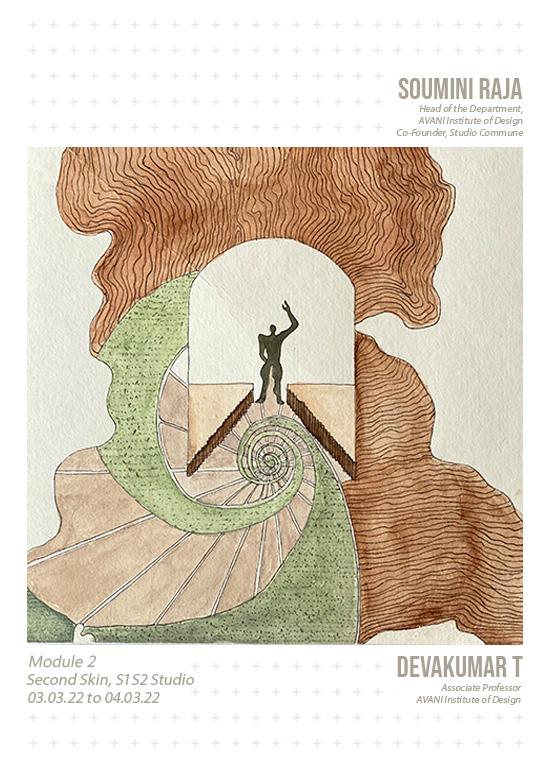
The workshop attempted to delve deeper into the nature of skin and its redesign through a wearable that acts as an extension of the body in space. It also tried to motivate the students to explore different local art forms, especially various movements in dance and its associated wearables and ornaments.
A Kathakali performance by SPICMACAY Chapter and an exhibition of wearables was also conducted as a second part of the workshop.

10
Written by : Foundation Studio Faculty Team
Related Study Program
The Architectaure of Kallayi’s Industrial Architecture
Semester VI : Related Study Program
Avani Related Study program has been envisaged to help students study various historical buildings / built environments. RSP II conducted during the Semester S5/S6 focused on the Minor Architecture of the Subaltern located within Calicut city. The RSP II intended to offer students insight into the relationship between the program, material tectonics, and the architecture of the place. It included thorough documentation of the overall structure, construction details, and artifacts that made the building and its architecture meaningful.
Once upon a time, the river was the main source of communal sustenance, the essence of civilization. The Kallayi river edge was renowned historically for timber industry-based trade links dating back to the 15th and 16th centuries. The waterways were extensively used for carrying timber from the forest areas in and around Nilambur to the various mills in Kallai near Kozhikode (Calicut). Rafts made of logs were taken downstream during the monsoon season to Kallai, where these were sawn to size in the timber mills dotting the banks of the river. During this period, Kallai is said to have been one of the most important centers in the world for the timber business. Up until the 1970s, more than 300 industries and 20,000 workers thrived on these banks. Today, the resultant vernacular architecture
and the industrial land remain in a state of decay along the ecologically fragile Kallayi river, becoming the city’s backyards, distancing citizens from their access to the urban commons. The community and the industries depended on the river for their sustenance. The changing environmental and economic policies, technological advancements, fragmentation of labor forces, land policies, etc. impacted the growth of the industry, leading to a steady decline. Several factories perished over the past three decades; the ones that remain are the only evidence of the utilitarian architecture of the past.
The RSP which was undertaken with the support of the Avani Heritage Cell was the first such attempt
to document the realities and transformation architecture of the region. It focused on sensitizing students and faculty researchers alike to the industrial architectural heritage which has shaped the city of Calicut in many ways.

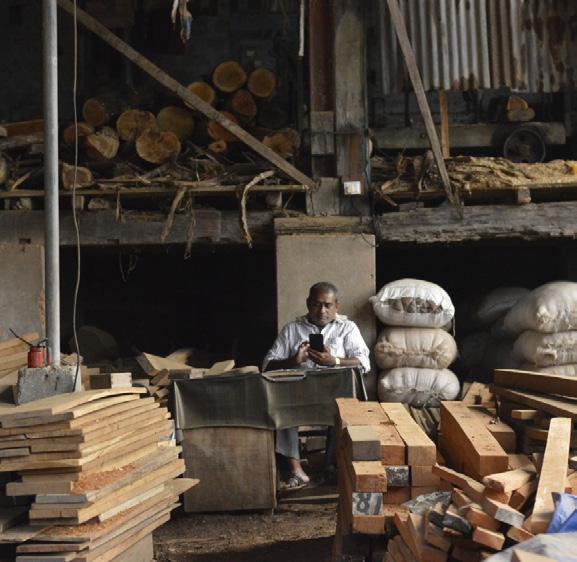
Faculty coordinators: Ar Aditya Nambissan, Ar Ambili S, Ar Gisny George, Ar Sanjay Kumar, Ar Satyajeet Sinha, Dr Soumini Raja, Research Assistant Ar Ashya K Suresh
Written by: Ar Satyajeet Sinha
01 11
Understanding the Architecture of Michabhoomi, Thamarassery
Semester IV : Related Study Program
Avani Related Study program has been envisaged to help students study various traditional and vernacular built environments. RSP l conducted during the Semester S1S2/S3 would focus on the indigenous building traditions active in the immediate neighborhood or in and around Calicut. The two components involved in the study were studying the context, reinforcing the socio-political layers of the community and measure-drawing that stimulates the student’s understanding and their abilities to appreciate and decode the built forms in terms of its “making”.

About the community, RSP I would study the neighboring community residing at ‘Michabhoomi’, which is predominantly a migrant group tracing their roots from different parts of the state. The settlement has a very diverse culture attributing to its share from the multiple regions across Kerala, sensitive political affinities and alignments, varying economic strata.
The Michabhoomi is characterized by numerous typologies of residences of varying scales, building materials and techniques and also houses community centers. A religious building (church) located in the adjacent plot is also significant for its architecture and its political connection of its landowners with the ‘Michabhoomi’.

Faculty Coordinators : Ar Devakumar T, Ar Krishna Salim, Prof Rajina Rahiman V, Ar Rajiv Babu, Ar Sebastian Joseph, Ar Varun Gopal
Written by: Ar Krishna Salim
02 12
Learning Together
The Avani Learning and Teaching Colloquium (ALTC) is a bi-annual forum for the Avani faculty cohort, Avani Advisors, Governing Council and students to come together to reflect on our academic practices, pedagogies, and scholarship towards strengthening our academic pursuits for the overall growth and collective development of the community. It was created to give greater agency, visibility and voice to the teaching cohort. Through sharing of experiences, engaging in debates, course iterations and integrations, continuous peer learning and by sharing roles and responsibilities, all members participate in building depth and coherence to learning goals and objectives across the five years of architectural education at Avani. ALTC is also a space for mentoring and professional development.
Winter ALTC 2022 was held on 26th February to 01st March 2022.
The Winter ALTC 2021 and Monsoon 2021 brought in discussions on values of Sustained Shared Thinking. These semesters posed several challenges to us, transitioning from home to campus and frequent encounters of intermittent lockdowns. The academic plan for the Monsoon 2021 was guided by our academic rootedness engaging in critical inquiries situated within the Avani Annual Research Symposium 2021 - Ecologies of Adaptation:

• Reconnections (re-narrating histories)Foundation Studio
• Living and Working: Realities of DomesticitySemester 03 and 04
• Magnitude of inequities and bracing for uncertainties - Semester 05 and 06
• Collaborations for a resilient future - Semester 07 and 08 (Practical Training)
• Vulnerable ecosystems and resilience - Semester 09 (Urban Design)
Throughout our academic engagement during the semester, including our studios as well as lectures and workshops, we posed/continue to pose some pertinent questions: What does ecological awareness offer to architectural pedagogy? What does altering domestic realities offer to the built environment design discourse? How do uncertainties intensify the already widening social inequities? How does resilience play a role in offering new opportunities to vulnerable ecosystems? How do we define a resilient future? Is there a need to re-narrate our past and build ‘re-connections? Monsoon 2021 also saw some success with faculty research and workshops. A team comprising Ar Ambily, Ar Satyajeet, Er Nima, Ar Anjali, Ar Vivek, Ar Thushara and Dr Soumini were selected by CoA to expand on their collective proposal on
EVENTS
01 13
Avani Learning and Teaching Colloquium 2022
“Decoding Malabar’s Urban Commons: Calicut City and its Backyard Architecture”, Urban Research Studio Project giving impetus to the Avani Malabar Studio. We also witnessed the inauguration of Avani Heritage Cell, a collaborative project undertaken by Ar Meenakshi, Ar Afifa and Ar Devakumar. We continued with our collaborations through Building Voices and Building Alliances cocurated by Ar Ujjayant, Ar Meenakshi and Ar Devakumar, and saw some brilliant lectures from Prof Rahul Mehrotra, Prof Viswanath Srikanthiah, Prof Tom Burkchart, and our own faculty members.
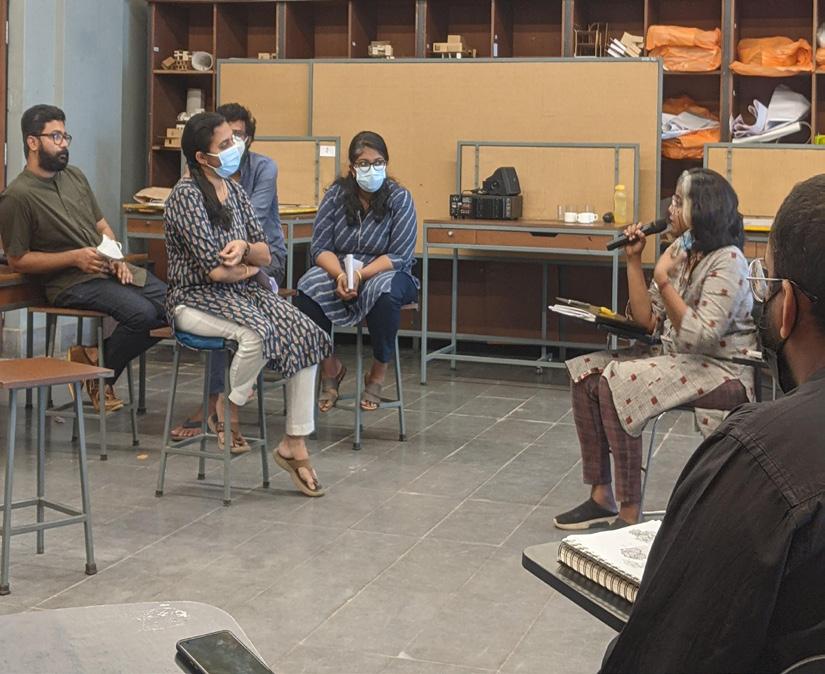
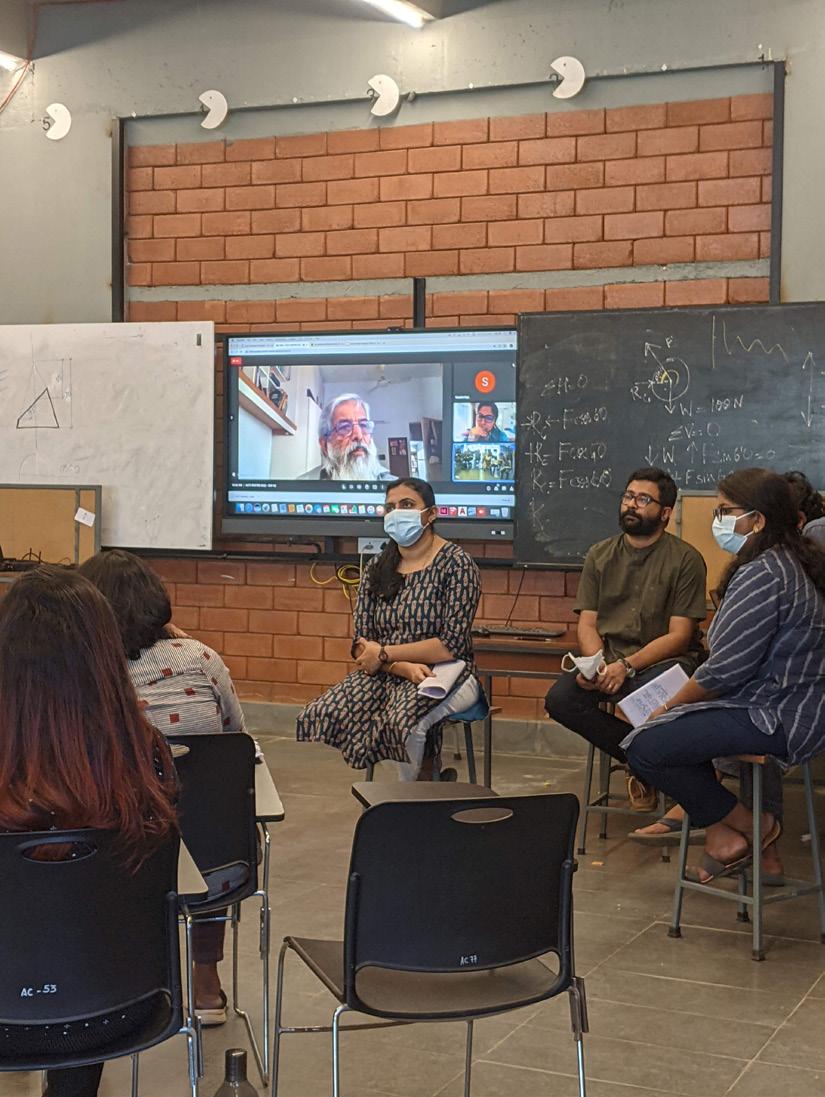
An array of skill building workshops made the Disha 2021 a memorable starting point for the current Foundation Studio team and brought Avani closer to the community of arts and crafts. We launched our inaugural set of RSPs at Ambayathode settlement and Kallayi timber industry and initiated Center for Innovation in Teaching and Learning to push our boundaries of pedagogical engagements beyond the walls of the classroom. These academic engagements clearly mark the strength of our faculty cohort, our collective vision for the institution’s future growth trajectory and willingness to collaborate and cooperate.

14
Teaching as a Process of Cooperative Learning
In the previous year, we emphasized on Sustained Shared Thinking as an academic practice to engage working with one another in an intellectual way to solve a problem, clarify a concept, evaluate an activity, extend a narrative etc. Through a shared thinking, both parties involved contribute to the thinking and develop their critical understanding of the concepts. We believed that this collective approach to teaching and learning can not only act as a strong support mechanism while we dribble our responsibilities at work and home but also an effective tool to blur the boundaries of academic binaries of teaching and learning, mentee and mentor, studio lead and supporting faculty and so forth.
achieve maximum academic productivity ensuring equal participation, promoting productive interdependence, mutual help and assistance, trust, constructive management of conflict, maintaining quality of interpersonal relationship and improved psychological health, this Winter
ALTC intends to initiate a cooperative learning approach to teaching at Avani.

Furthering our investigations through sustained shared thinking, this year, we will be situating our engagements within the academy as a conscious process of cooperative learning, rooted in a positive social interdependence (Johnson and Johnson, 2006) within the cohort. With a goal to
Through the Winter 2022 ALTC and the next we shall raise some pertinent questions: What has transitions and uncertainties taught us on architectural pedagogies? What does collaboration mean if we view learning not as an individual’s productivity or success but as a vehicle for holistic development within the community? How would collaborative learning manifest in our pedagogies? How would it impact our studio culture, student-teacher relationships, accessibility, spatial logic and content generation?
Written by: Dr Soumini Raja
15
A Visit to Avani Community
Written by : Ar Monisha V Kunjumon
Prof Roger Connah, Avani International Visiting Professor/Mentor had been in residence from 19 April 2022 to 15 May 2022. He had been offering lectures and workshops to students and faculty alike. Prof. Connah is a critic, writer, filmmaker and scholar from Ruthin, North Wales, UK. He is currently professor of architecture at the Azrieli School of Architecture and Urbanism at Carleton University in Ottawa, Canada. With 20 books on architecture, art and society, the most recent of which is ‘Being: An Architect’ (with Ian Ritchie, Royal Academy, UK 2013), Roger Connah has been a voracious writer feeding the minds of his readers with his thoughts on what is and what can be. His dynamic pedagogy is often a catalyst to push the limits of systems as we know it.
His thoughts on the same can be found in his book The Age of the Pamphlet and in a series of writings critically commenting on the existing pedagogy and established systems of education.
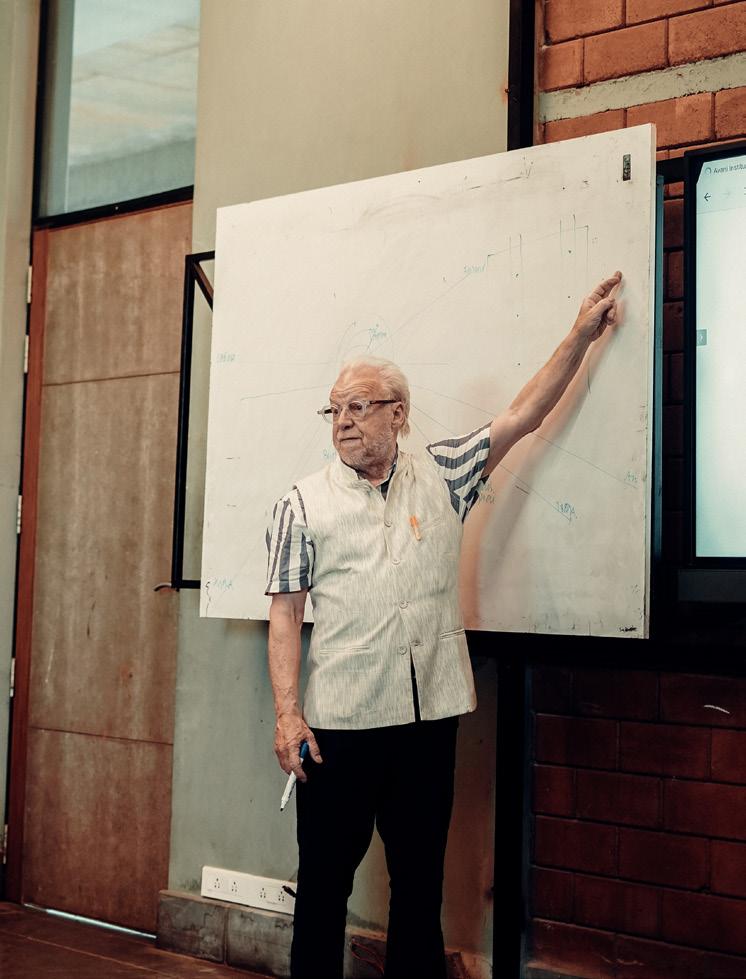
While at Avani, he has been a friend, mentor and guide to the students and faculty alike. His contagious enthusiasm and energy in his studios and classes was definitely a force to be reckoned with. His guidance and mentorship to especially the Thesis Studio, the Faculty Reading and Writing sessions, the informal discussions over coffee have all been very engaging and thought provoking.

02 16
Prof Roger Connah at Avani Campus
AMEYAM 2022
Commencement Day Ceremony of Batch 2015 and Batch 2016
The Institute celebrated its first graduation ceremony on 5th March 2022 at its campus in Ambayathode, Thamarassery in order to acknowledge it’s responsibility to society by training a group of passionate young architects; to honor the grit of its graduates who graduated during tough times amidst pandemic; and to honor the faith of its well-wishers. In addition to receiving graduation certificates, proficiency awards, best thesis awards, and best student awards, the students of the 1st and 2nd batches, Batch 2015 and Batch 2016 received graduation certificates. In celebration of the inaugural event, renowned architects from the architectural fraternity graced the occasion, including Bangladeshi architect Marina Tabassum, President of the Council of Architecture (CoA), Ar Habeeb Khan and Prof Neelkanth Chayya, and Murali Cheeroth, Chairman of Kerala Lalithakala Academy, both acclaimed academicians and advisors to Avani. In addition to family and friends of Avani, the event was graced by the joyous parents whose continued faith and support have made Avani a prominent name in architectural education.
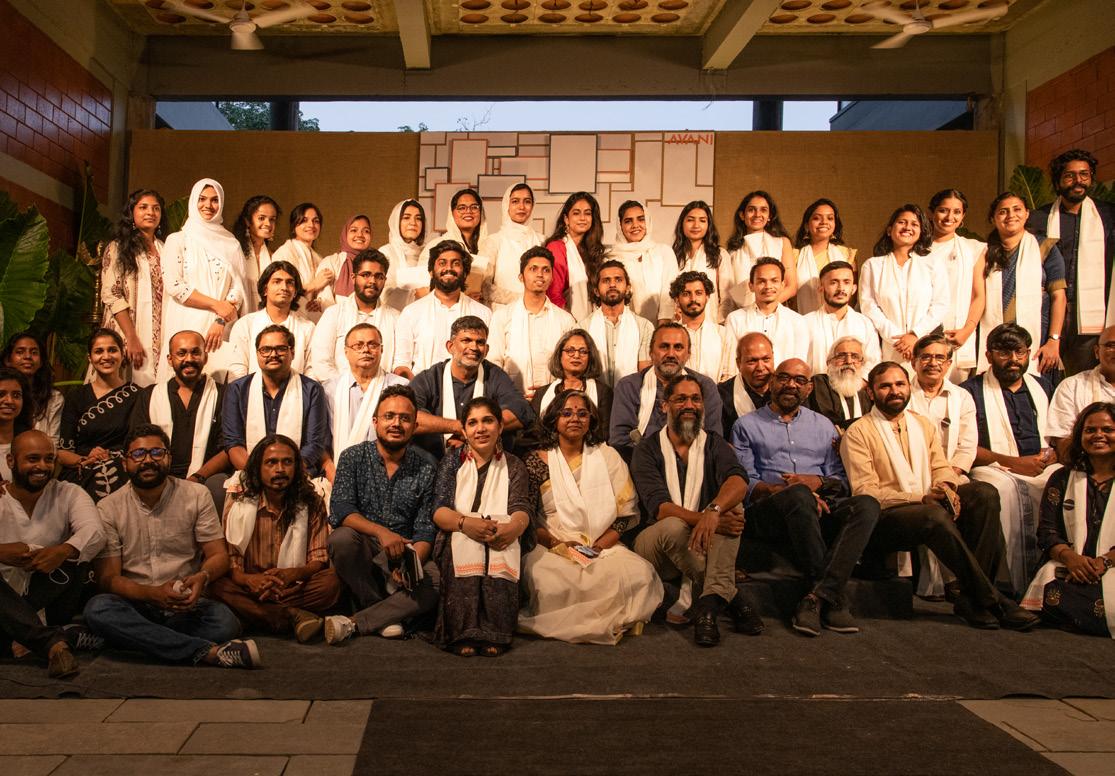
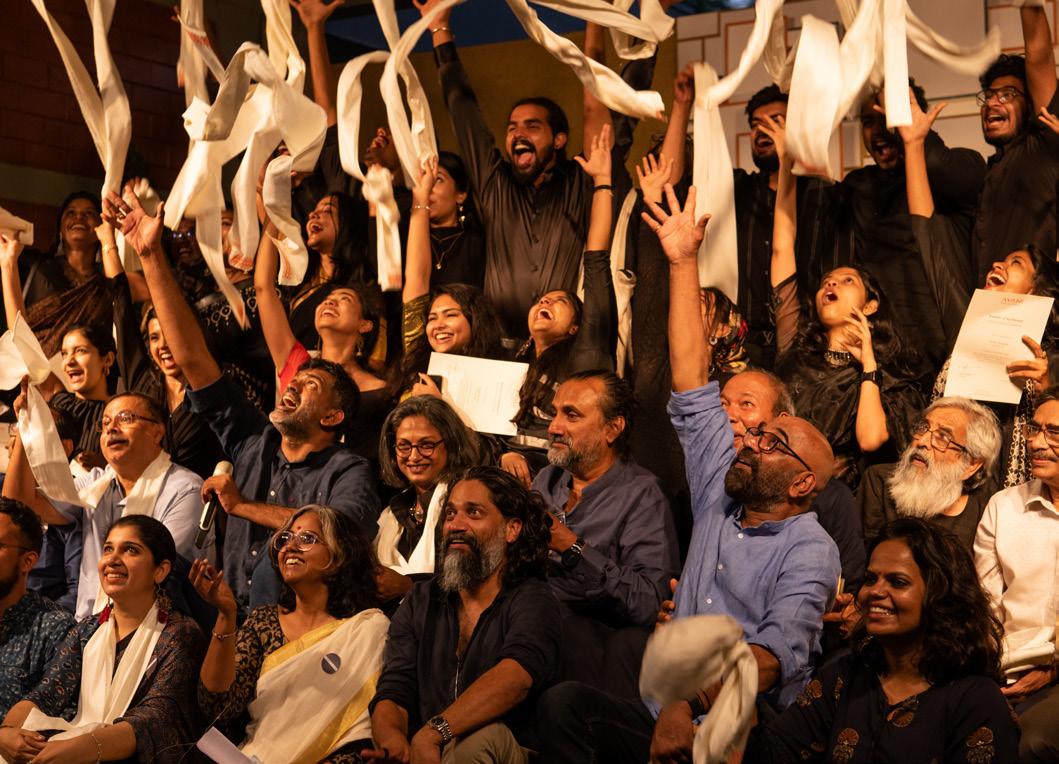
 Written by: Ar Rajiv Babu, Ar Satyajeet Sinha
Written by: Ar Rajiv Babu, Ar Satyajeet Sinha
03 17
CAMPUS FURNITURE

Conducted over three days, the faculty at Avani engaged in a Wattle and Daub - Composite Wall Building Workshop to combinedly create a campus furniture in the dense plantain farms. The bamboo, cut from the campus, was split into smaller cross sections of 1/2” x 1/2” and closely woven to form the wattle. Clay rich mix of chopped straw, soil, and rice starch, manually mixed with legs, was applied on to the wattle to finally shape a ‘bench’. Ornamented with patterns drawn over the clay-finishing coating, the bench was left to dry naturally. This low-impact sustainable building technique was celebrated with a large faculty participation.


 Written by: Ar Sebastian Joseph
Written by: Ar Sebastian Joseph
04 18
Hands on Wattle and Daub Construction Workshop
To be Heard
Building Voices, Building Alliances Lecture Series
The “Building Voices, Building Alliances” lecture series takes as its point of departure the importance of architecture’s embeddedness within wider spatial politics and its participation in the discourse on social responsibility. In its third year, the lecture series will further the inquiries that originated in the Avani Annual Research Symposium 2021: Acknowledging the tumultuous and uncertain period that we are living in, the current Academic year at AVANI (2021-2022) is oriented towards a theme of ‘Ecologies of Adaptation’ and all academic practices including studio inquiries are structured around this very theme.
The BVBA team is composed of Ar Afifa Nuzhat, Ar Arighna Mitra, Ar. Devakumar T, Ar Meenakshi Dubey, Dr Soumini Raja & Ar Ujjayant Bhattacharyya. As the convenors of the program,

Youtube links:
Written by: Ar Ujjayant Bhattacharyya
we ask: What does ecological awareness offer to the architectural pedagogy? What does altering domestic realities offer to the built environment design discourse?
How do uncertainties intensify the already widening social inequities? How does resilience play a role in offering new opportunities to vulnerable ecosystems? How do we define a resilient future? Is there a need to re-narrate our past and build ‘reconnections’?
Dr Soumini Raja was the first speaker of the series who explored the city ecologies and architect’s agencies. Prof S Vishwanath then spoke about the wonderful possibilities of water engineering. Dr Anu Sabhlok talked about gendered infrastructures in cities of migration. Finally Ujjayant Bhattacharyya took us into a journey of sacred speculations.
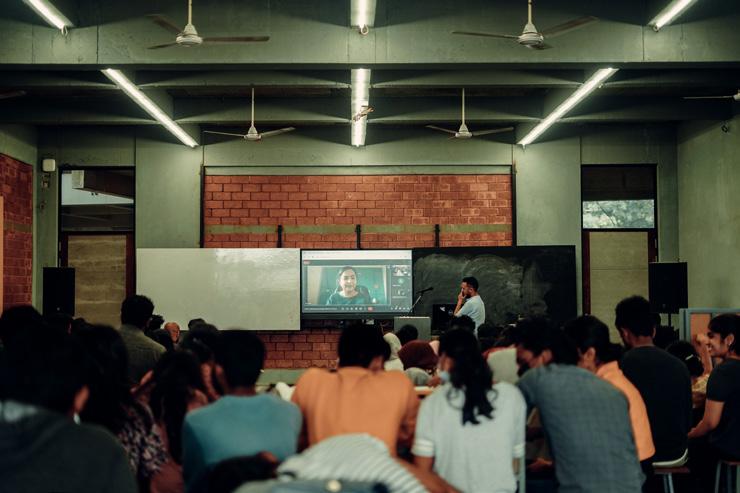
Dr Soumini Raja : https://www.youtube.com/watch?v=Y-KHpGBzIkg
Prof. S. Vishwanath : https://www.youtube.com/watch?v=OwzG7ULFzE0
Dr Anu Sabhlok : https://www.youtube.com/watch?v=KvahzujqkrY
Ar Ujjayant Bhattacharyya : https://www.youtube.com/watch?v=fg4kHLm_5YU
05 19
Capturing Context
Dubai Expo Traveling Photography Exhibition
At the core, William is an artist, who is in love with color palettes, geometry and textures. This collection of work is conceptualized to help the viewers visualize Expo 2020, Dubai through his lens.
Being an architect has helped William to develop a keen eye for capturing forms, and manipulating proportions and scale. In this series, we see the expansive and expressive sky, coupled with patterns and scale, as well as the strong physical presence of form. He is an observer and critic at the same time, which brings together the essence of design, tessellations, and textures in a unique way.
As an academic in the field of architecture, William has devoted this photographic series to learning, listening, capturing, and molding from his hands to yours.
 Written by: Ar William George Kennedy
Written by: Ar William George Kennedy
06 20
Embracing Culture
Inauguration and Events under SPICMACAY Chapter
As an institution, Avani understands the essential role that arts and crafts play, that urges people to empathize with others and gives a tremendous opportunity to reflect on the human condition. To enhance this, the chapter of SPICMACAY (The Society for the Promotion of Indian Classical Music And Culture Amongst Youth), a non-political body that recognizes the various artforms and artists all over India, was inaugurated in the month of March 2022.
E01 : Self Expression of Context, Kathakali Performance
As an opening ceremony, a mesmerizing Kathakali performance was conceived on the tale

‘Keechakavadham’. The evening was made much more memorable with the much interactive lecture demonstration by YSNA Awardee, Kottakkal Sri Unnikrishnan.
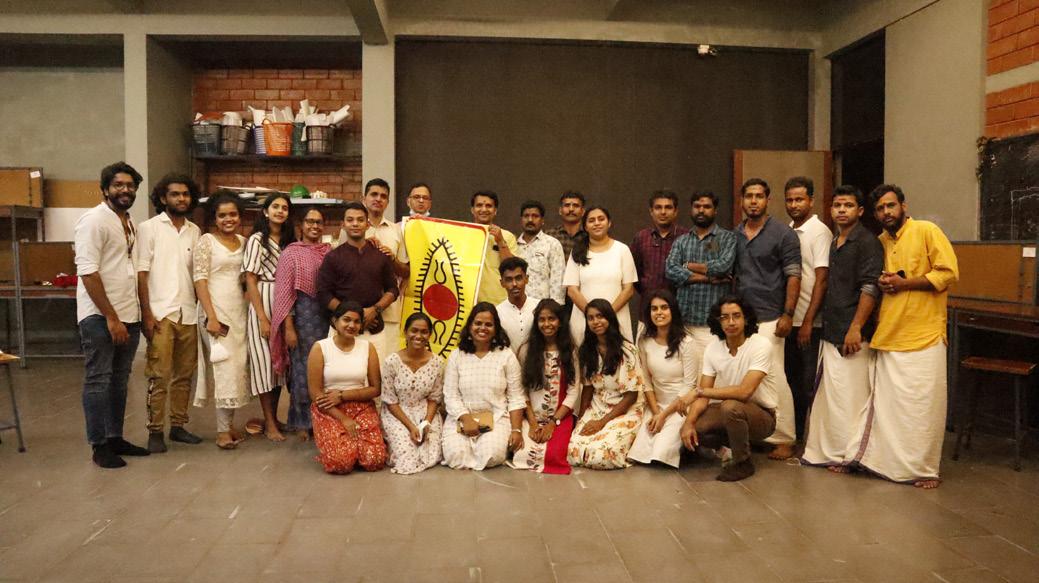
E02
: ‘Nizhalattam’, Tholpaavakoothu
The second event under the Chapter was conducted in the month of April 2022, where the traditional artform of shadow puppetry, ‘Tholpaavakoothu ‘, on the tale ‘Sita Kalyanam’ was acknowledged. The lecture demonstration for this session was conducted by Padma Shri Ramachandra Pulavar, who is an acclaimed pioneer in the field.
Written by: Ar Anjali Sujat
07 21
On the Same Page
Faculty Reading and Writing Fellowship

The Faculty Reading and Writing Fellowship, is a weekly literacy interaction session for faculty conducted every Wednesday evening 04:00 PM to 05:00 PM. The session is designed such that each faculty member gets encouragement to explore the world of literature. Each session is led by an individual, who gets the freedom to share with the team their interesting works of poetry, regional literature, fictitious and non fictitious reads, movie scripts, works of academic and professional relevance or any written work of choice. The idea is to open the vast knowledge banks from varying genres and regions for all to be aware, appreciative and respectful of.
For the past three weeks, the Fellowship was honored to have the presence of Prof Roger Connah, who introduced very insightful points to ponder over. During the first of his sessions, Prof Connah spoke about teaching pedagogy from his experiences, and a few points for the faculty to self evaluate. The second was an interactive session to understand the interests among faculty members to indulge in writings, research and publications. The third, again was the closing session where he posed very relevant questions for the faculty to consider while introducing and attempting to encourage
reading exercises among students, the factors behind preferences in books in the era of so much readily available content online.
Preceding to Prof Roger’s sessions, Ar Krishna introduced her poetry publication - Breathe, with the team. Four poems portraying different stages of life were read out by faculty in turns. A wonderful session which was enhanced by participatory reading by the team. This session was preceded by an introduction to the lyrics of “Kozhipunk” by Ar Rajiv. The song which had been doing rounds amidst Malayalam internet content was originally written by the renowned poet K Satchidanandan and talks about Indian socio-political scenarios. A light hearted yet insightful revelatory introduction to the works of Shri Satchidanandan.
 Written by: Ar Gisny George Kurian
Written by: Ar Gisny George Kurian
08 22
Campus Bird Count
Understanding your Campus Ecosystem
A Campus Bird Count was organized on 27th February 2022 within the Avani campus under the expertise of Ar Shyamkumar Puravankara. 31 diverse species of birds were spotted by the team. With keen eyes and ears, our bird enthusiasts became a part of silence to watch their feathery friends live.

You can check out the species here.
https://ebird.org/tripreport/40950
 Written by: Ar Monisha V Kunjumon
Written by: Ar Monisha V Kunjumon
Museum in the Making
“Museum in the Making”, is the first semester Foundation Studio work exhibition that was conducted for the Batch of 2021-22 in the month of March”.
Museum in the Making is a celebration of several notions of making, which in itself is an act of making the museum in the first place. The binaries - maker and the made, contribute in reinforcing the relationships of individuals with their surrounding ecologies, allowing “Re-connections” and building something up that is meaningful of, for and from the context.

09 10
23
The Foundation Studio, looks at our relationships with the region and context whilst attempting to understand and interpret these intricacies by empathizing with materials and fostering community engagement.


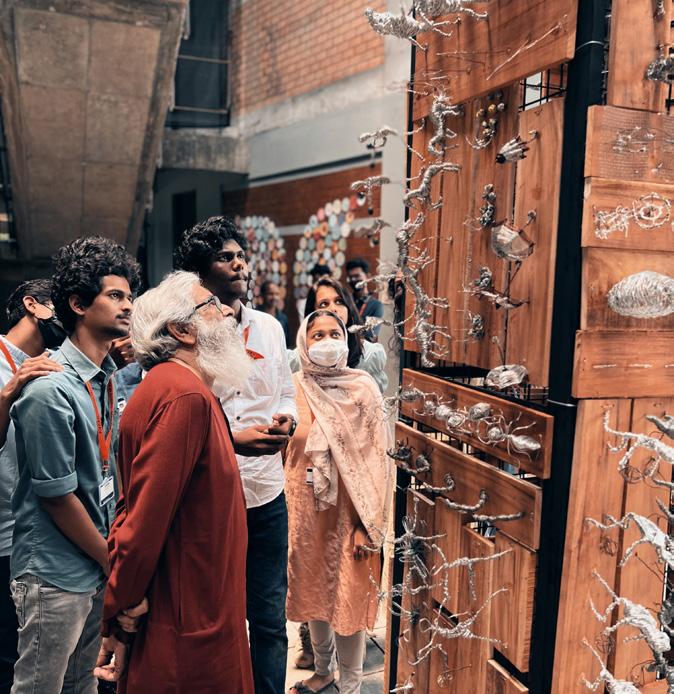
The Studio integrates several subject domains including Design, Visual Arts, Design Theory etc. to weave multidisciplinary learnings under a single fabric and allow individuals to Re-think, Re-look and Re-Learn about our immediates and beyonds. The exhibition showcases the notion of crafting, making, materialities and collectives, all intersecting across studio domains.
Envisioned in three modules: Discovery, Inquiry and Engagement, the concluding project of the Foundation Studio, “A Museum of Ideas”, shall reflect all the contextual, material and built learnings over the course of two semesters and first two modules with extended exposure to the notion of “making”.
Faculty Members : Ar Anjali Sujat, Ar Devakumar T, Ar Monisha V Kunjumon, Ar Sharan Krishnan R, Ar Ujjayant Bhattacharyya, Ar Usman Pakkath, Ar William George Kennedy
24
Written by: Ar Ujjayant Bhattacharyya
FACULTY ACHIEVEMENTS
Recognizing Architecture at its best
Avani
Faculty
Members at IIA Kerala State Awards

Sister Lini Memorial Bus Bay
Ar Vinod Cyriac Practice : SpaceArt
Responsible Architecture
In the frontlines of the war against the dreadful Nipah virus disease was the crusader Sister Lini PN from Perambra. Sister Lini was 28 years old when she contracted Nipah virus and succumbed to death while treating a patient who is believed to have been the index patient of the deadly NiV outbreak in Northern Kerala in 2018.

Conferring Sister Lini with the National Florence Nightingale Award 2019 posthumously, Honourable President of India, Sri Ram Nath Kovind honored her memory, commendable efforts and services. The memorial and lamp; bus bay at Kallode, Perambra, a government-initiated project is a memorial in honor of the selfless and caring nurse Lini PN.
The site is a linear stretch of land in Perambra, abutting the National Highway 54, near the Government Taluk Hospital where Sister Lini worked. For her daily commute, she had been using the existing bus stop here, which was dilapidated.
The concept of the memorial is synonymous to the ‘journey’ reflected in Sister Lini’s last words to her husband. “.. I am almost on the way. I don’t think I will be able to see you again. Sorry. Please raise our children well.….” – Sister Lini PN. This bus bay is a living memorial to Sister Lini and the 17 other people who died due to Nipah in 2018.
The design includes a memorial and a bus bay. The memorial has been designed in a minimalistic and thoughtful manner. An illustration of sister Lini, plaques with her last words and a brief description on the Nipah outbreak are displayed in a landscaped area. The bus bay is designed as a semi-open structure, rectangular in plan with built- in seating. Exposed laterite walls and single-side industrial sloping roof comprise the main structure. Between the laterite walls, lightweight trellis has been provided to grow creepers.
The bus bay was planned around the existing flowering trees in order to conserve them and evoke a memory. The planting included along with the bus bay represents the hope and faith in mankind. Half walls with candle-like installations symbolize the lost lives during the Nipah outbreak.

01
25
Conservation Projects
Project : Design Ashram
Ar Nimisha Hakkim Practice : DAC
The focus of the design was to conserve the heritage of the area while bringing in modern functions to the space. It has been inhabited by Gujarati traders for centuries.
More than inspiration it was the need to revive a building typology known as pandikashala (warehouse on the ground floor and residential above, surrounding a central open space) which were spread across this part of town.
On a different note, the architects wanted to produce a space where like-minded people could connect, convene and create ideas. A place where shared spaces could accommodate a plethpora of functions without disturbing each other layered with a serene calmness the style of architecture and the open space offers.
The street and the area around it had been a close knit residential area for the Gujaratis and bringing in a commercial element to a dense residential area proved difficult. With the shift of the nucleus of the town, the street became a commercial hub primarily after the introduction of Design Ashram which started bringing in a high footfall of people.
Salvaging essential elements of the previous built structure and building along its footprint was through a calculative approach not to disrupt the structure. Most parts of the old building was used in the new design with the addition of clay tiles on steel rafters, steel beams to reinforce the slabs and bringing in wooden columns and doors and windows that blend with the context.
The old roof made of wooden rafters that had decayed over time were replaced with steel one covered with the same tiles. The central courtyard was earlier used to dry spices and store goods, in the pandikasala at a time when Gujarati traders were at the heart of trade in Calicut.
The new design added a Peepal tree to which the design was based around, as a focal point, along with an open stage for performances and a dining area.

02
26
Public Space Cultural Beach
Ar Vivek P P, Ar Nishan M, Ar Anitha Choudhuri Practice : De Earth, SpaceArt

The past - most of Kozhikottukar or people of Calicut who grew up in the city have childhood memories woven together by the waves, the wind and the familiar sight of the dilapidated north piers.
Intend – Calicut beach is an important spine in the urban structure of the city. The large paved beach which had lost its character was recreated to bring in an active public space that has a lot of micro potential values to conserve and restore the historical sea.
To host cultural activities of such scale, it demands multiple spaces which can be activated simultaneously, which can easily house lakhs of people throughout the day and night. The paving pattern gives the users a sense of direction and a sense of understanding on how to use various performance venues.

The lighthouse, a critical part of the cultural beach project, was left as a waste dump yard with no access to the public. By cutting through the landscape and creating a spine with the walk around the lighthouse, the space was critically integrated to be the entry plaza of freedom square and cultural beach. An open-air theater was carved out of the landscape, without disturbing its natural setting, which can house the discussions regarding heritage and also become the starting point of heritage walks.
The organic edge along the beach side ensured that the newly developed space merged into the natural setting of the beach. The raised area near the north pier becomes a viewing platform to appreciate. Special lighting was considered to ensure that the space is activated during the night without hindering the experience of the beach.
This, the Cultural beach becomes an open palette for exhibitions and multiple activities from large cultural events like Kozhikode Mahotsavam and KeralaLiterature Festival, to small events like protests or flash mobs, a walking path etc that help people come together and interact keeping the place alive,altogether creating a space that responds to its historic past and livein-the-present.
03 27
Residential Buildings (single dwellings)
A Home Liberated
Ar Vishnu K
Title : Commendation
Practice : Asylum (Collaboration of Kaav architecture, Studio Commune and Ego Design Studio)
Ar. Vishnu K, Assistant Professor (Visiting) along with his collaborators has won a commendation in the IIA Kerala Annual Award for Excellence in Architecture 2021 for the Category: Residential buildings single dwellings.

His project “A home liberated”, situated in Adoor won the commendation of the jury comprising Ar. Bijoy Ramachandran, Ar. Madhav Raman and Ar. Girish Doshi, for its subtle act of responding to the needs of a 150 year Tharavadu/Courtyard house and its inhabitants. The project was a result of a collaborative practice by Studio Commune, Ego Design Studio and KAAV architecture. “Architecture is a political art.

The home liberated was an attempt to distance the architect’s ego from the design process and listen to the building that existed for several years on the site. Tharavadu was our mentor from whom we learnt the act of subtle existence on site. The design became a palette of glitches that offered an extension to Time”.
Written By : Respective Awardees Edited By : Ar Anjali Sujat, Radhika Krishnan (Batch 2020)
04 28
A Teardrop
Poetry Publication
A poem “A Tear Drop” was published in the anthology series “Paradise” by the Writers Order for their January 2022 print and e-book releases. It is the story of a woman who realizes how deeply she truly loves her lover who is living across the country. The pain of waiting is now evident to her that her heart does indeed beat for someone else. Her ill fate and the slow-moving time are both frustrating her. Her tears of joy begin to roll down her cheeks and all of a sudden, everything makes sense.

Here below is an extract from the poem :
“But then I asked myself This is not the first time a tear has escaped from the prison of my mind Then why do I feel strange suddenly?”
Written By : Ar. Krishna Salim
Attaining great Heights
Distinguished
Student
Award - CEPT 2021
One of our youngest faculty members, Ar William George Kennedy was awarded the Distinguished Student Award.
He is a Masters graduate from CEPT University 2021, with specialization in Masters in Building Products & Systems.


 Written by : Ar William George Kennedy
Written by : Ar William George Kennedy
04 05 29
Academic Excellence
Top in Punjab University - Post Graduation and Thesis - 2021
Ujjayant Bhattacharyya topped his post grad thesis program at Punjab University for his thesis : Tectonics of Sacred Synthesis. The thesis has been widely recognised and celebrated not only within the academic bounds of the university but also beyond that internationally.

The design thesis intends on understanding and analyzing the contextual phenomena of the idol making community in Kumartuli, Kolkata and subsequently propose careful injections into the site in the form of dwelling reforms , ancillary infrastructure and urban guidelines in the wake of craft, heritage and celebrations.

A tactical and collaborative approach is adopted for the community development to stay true to the essence of the precinct.
Written By : Ar Ujjayant Bhattacharyya
06 30
STUDENT ACHIEVEMENTS
Moving Forward: Architecture From The Ground
Best Thesis Awards
Alan Georg Joseph of Batch 2016 has secured the following awards for his thesis “Punarjeevanam” :

National Award for Excellence in Architectural Thesis by the Council of Architecture 2021



Published in JIIA National Magazine March 2022

JK Architect of the year - Winner Edition “Distinction”, JIIA Journal, - April 2022
Published in The Neptune Glitz, Architecture and InteriorNational Design Magazine - June 2022
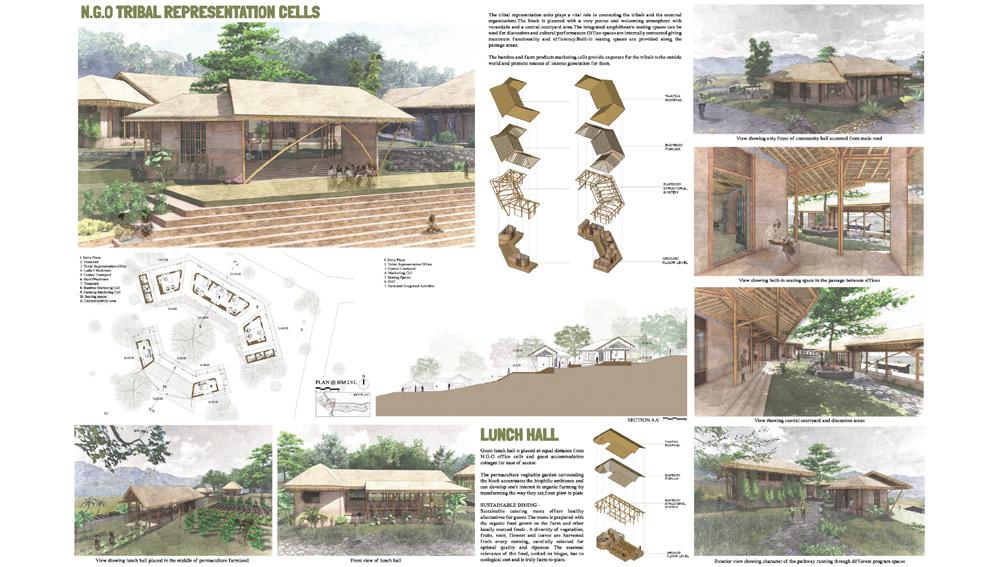 Written By : Ar Anjali Sujat
Written By : Ar Anjali Sujat
01 31
Reaching the Top
NASA 2022 - Le Corbusier Trophy








Avani joined NASA India in its 62nd year to open up the world of sharing of knowledge and interaction with students from all over India. After being a new member college in the first year, Avani started spreading its wings both at NASA design events and cultural activities.
The 63rd year was indeed a crucial and a special one for Avani being our first year of participation at NASA India. We started with the ANDC trophy. Although adapting to an online medium was challenging, students were all the more excited to take up the challenge. There were intense brainstorming sessions fueled by active discussions from the faculty cohort.
All the students came together in understanding the brief and working towards a universal design for the Bus terminal. There were two entries submitted by our unit with the site being at Calicut so that all the students had an idea of the context during planning and designing.




As the results were published our college came in the list of Top 100 ANDC colleges, a happy news to all the students who worked behind the trophy and the college as a whole as this was our first ever participation of a NASA trophy.



Selected Sheet from Entry 2:
 Selected Sheet from Entry 1:
Selected Sheet from Entry 1:
SECTION 1 SECTION 2 SECTION 3 SECTION 4 SECTION 5 02 32
Writing Architecture Trophy
‘Designing an Answer’
Our students have always been great at expressing their opinions and ideas through writing and therefore we gave it a try on the Writing Architecture Trophy. We submitted two entries, one from the 2016 batch and another from the 2018 batch. The papers were on different relevant topics of architecture and students wrote about their views on the same. Both the entries were shortlisted.


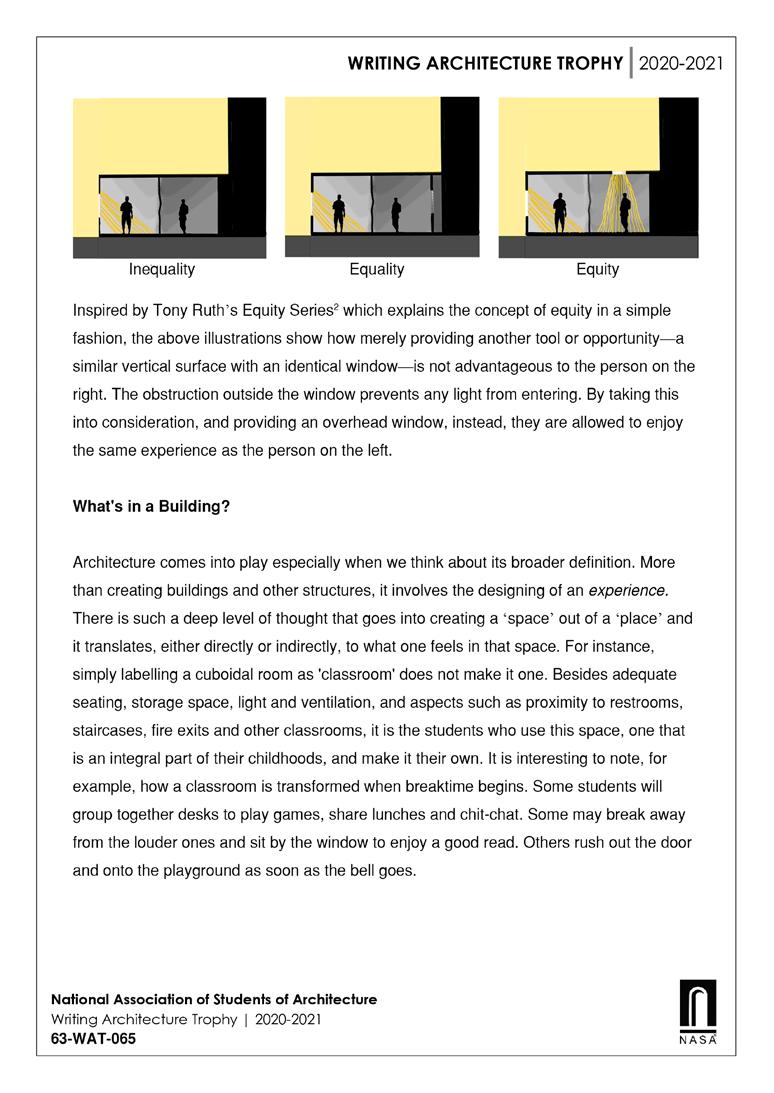
Shorted Entry 1 by Batch 2018 on ‘Designing an Answer’ :
Iman Hashim
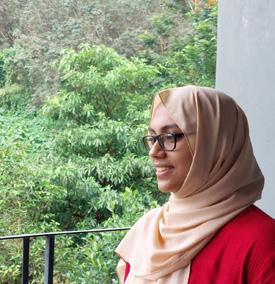
Fathima Shanna
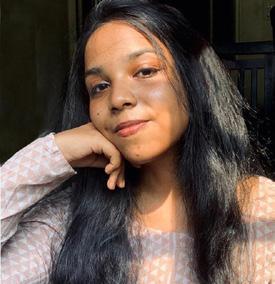
Sneha Nour
Following is an extract from the entry :

03 33
‘Moving Forward: Architecture From The Ground Up’

“To whom does the city belong to and who all belong to the city?” This was a question that arose among us during a casual tea-time conversation. Although we couldn’t come up with a definite conclusion, we realized that our answers to these two questions were quite different.
For our academic projects, we often create fancy building sections and renders with well-dressed men and women walking dogs and jogging, kids going to school and fancy cars lined up in front of our buildings. If all our designs and buildings are serving the above mentioned category of people, where do the rest of the people go?
We are taught about different local communities through subjects like sociology and vernacular architecture in the course of our formal architectural education, but there is an apparent disconnect between the way architecture is taught, and the lived realities of communities surrounding us.


Social stratification has always existed in India, but has often been glorified in the name of history and culture. India's caste system is among the world's oldest forms of surviving social stratification. The origin of the Indian caste system has many theories behind it. Some of them are religious, while others are historical. The religious theories explain that according to the Rig Veda, which is an ancient Hindu book, the primal man, Purush, destroyed himself to create a human society and the different parts of his body created the four different varnas or castes. Historically, however, it is believed that the caste system began with the arrival of the Aryans in India around 1500 BC. The ancient Aryan society grew into a patriarchal society where both boys and girls take identity from their father with only a few examples of matrifocal and matrilineal structure. Patriarchy, caste system, and other religious beliefs together create a complex social mixture that controls and creates a set of regulations for the society, especially women and other minorities.
Moving forward to 2020, India is now a developing country with a growing economy slowly adapting to modern reforms and policies. But unfortunately social stratification still exists largely in India, across a broad range of categories such as religion, caste, sexual orientation, age, physical and mental abilities, and many more, although it’s made less visible to the naked eye. Architects and Planners are involved in designing for the development of community now more than ever in India, and yet they still seem to lose sight of the community itself, which often forces the disadvantaged to resort to squatting and other methods of survival.
Covid-19, climate change, rapid urbanization, and other development projects have brought devastation to the marginalized population of India, leading to a mass displacement of the economically and socially disadvantaged. Heavy monsoons have resulted in fatal floods and other natural calamities for the past three consecutive years, causing havoc in states like Kerala.2 People who were once safely sheltered suddenly turned into refugees. The global pandemic has further forced more people onto the streets. These communities consist of people from different age groups, religions, castes, genders, sexualities, etc., and are rehoused into systems that are barely designed to fit their needs. Designers have important roles in supporting these communities through more planned community development solutions that should include detailed studies of what the community lacks and finding, developing alternatives to evictions, and eradication of the community Often, the planner s biases and ideologies overshadow community feedback, impacting the users severely Working with these communities, we could appreciate their existing cultural, social, and economic aspects, and suggest a design that will enhance the positive and discourage the negative aspects observed. As trained professionals, architects can see both form and function and can facilitate communities to make better use of their resources and
techniques. In turn, they get an opportunity to learn about indigenous construction methodologies and materials, making
population is predicted to be living in slums by the next century the need for responsive architecture is extremely urgent. Addressing the issue in India, King says, “India’s peri-urbanization is at the same time its greatest challenge but also its greatest opportunity If done right this can result in positive development lifting millions out of poverty and if done wrong these disconnected spaces will be sources of conflict.”
51664 handmade-schoo -anna-her nge -e ke-roswag Accessed 26 Nov 2020

The draw ngs show the typica p an and sect on o c uste sep ic anks that Ju ia K ng has worked on in De h The exis ng l ved rea i es o he peop e a e enhanced w hou dis urbing he r se t ements and home mage Cour esy of ht p: www u a-king com
Today, we see dozens of housing projects being built devoid of character without addressing the core needs of the people, only to be demolished years later when they're recognized as failures. The current development projects are the potential slums of tomorrow With the surge in population and rate of urbanization, more “urban metropolitan” centres are coming up but are failing to address the deteriorating quality of life lived by millions of people. There are many architectural discourses about equity these days, and it is getting reflected in practice. The need of the
Moving Forward: Architecture From The Ground Up
Kera a s a es at ood havoc o h d s ra gh year - kera a Accessed November 25, 2020 ht ps / www h ndustan imes com kera a/ke a a-s a es-a -f ood-havoc- o - h rd-st a ght-yea /story-Yg1hAkY c7UU 3PR2OZgaN h m H s ory o he nd an Cas e Sys em and s mpac on nd a Today " Accessed Novembe 25 2020 ht p /d g a commons ca po y edu cg /v ewcon en cg ?a t c e 1043&contex socssp
have crucial roles in facilitating and empowering communities
of
to understand their expectations and
Handmade Schoo by Anna Her nger + E ke Ro wag n D na pur, Bang adesh unde he MET Mode n Educa ion and Tra n ng Ins i ute METI enables chi dren and young people n he eg on to take classes up o he age of 14 and prov de workshops o rade-o ien ed p o ess ons The dea s to p ov de he rura popu at on w h access to good ho i t cal y-or en ed educa ion The pro ec aims to imp ove he qual y of l ving n u al a eas o coun eract he con nuing popu a on m g at on o he c t es H s o ic bu ld ng techn ques are deve oped and mproved and he k l s passed on o oca t adesmen ran form ng n he proce s he mage o he bu ld ng techn ques (Her nger Roswag 2010) (Pho ograph Cour esy: Ku t Hoe bs Julia King, who is also referred to as the “Potty Girl”, has often talked about the importance of participatory designs and the need to provide the underserved communities with infrastructures that they lack. The decentralized sanitation system that she was
part of designing, has managed to enable households to have toilets in communities that earlier resorted to open defecation. According
her communities don’t necessarily need what’s traditionally considered architecture today as they are capable of building homes and cities on their own. Rather designers could put their architectural skills and knowledge towards designing and implementing
communities truly
urban
3 Handmade Schoo / Anna Her nger + E ke Roswag | A chDa y 4 Ma 2010 h ps: www a chda y com
it a two-way process. Architects
by involving them in the design development process. A participatory approach would create a sense
belonging and ownership to the inhabitants, enabling architects
needs, based on a more accurate understanding of their cultures and perspectives. This would redefine the role of an architect from that of a grand designer to someone sensitive and socially responsible, enabling an exchange of knowledge, and making it a two-way process.
a
to
what the
need. Now that the world’s population is turning overwhelmingly
and about a third of the
5 "Why Equi y n A ch tec ure Mat e s Equ y by Des gn EQxD " ht p /eqxdes gn com/why-equ y- n-arch ecture-ma ters Accessed 26 Nov 2020 4 " n roduc ng "Po y-G r " The A chi ec of he Fu u e? A chDa ly " Accessed Novembe 26 2020 h tps /www archda y com 529934 n roduc ng-po ty-g r - he-a ch tec -of-the- u u e
04 34
hour is not fancy and fashionable architecture, but rather architecture which acts as a mindful service in providing fair and just access to the resources and opportunities necessary to thrive.
Shortlisted Entry 2 by Batch 2016 on ‘Moving Forward: ‘Architecture From The Ground Up’ : Aiswarya Vijay Ananya A P Following is an extract from the entry:
Mohammad Shaheer Landscape trophy
Our next and most prestigious trophy was the Mohammad Shaheer Landscape trophy for which we submitted a single entry. The design planned as modules that can be installed along the stretch of Canoli Canal was shortlisted by the jurors for the second round.
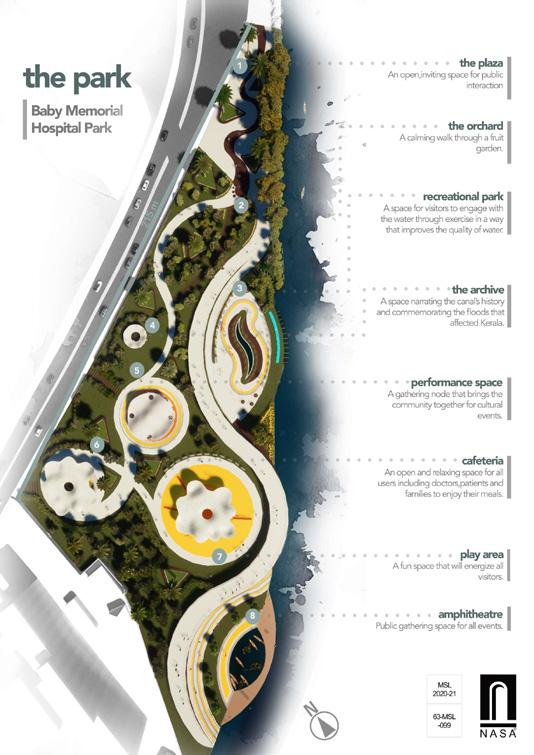

The second round of jury happened online and on the day of online valedictory ceremony it was announced that our unit won special mention for the trophy. Later students were honored with certificates, trophies and cash prices from NASA presented to them by Sri. Pradeep Kumar , a wellwisher of AVANI, at a college event.
The entry was submitted by :
Aneez Mohammed
Janet Bridget Joyson
Renna
Fathima

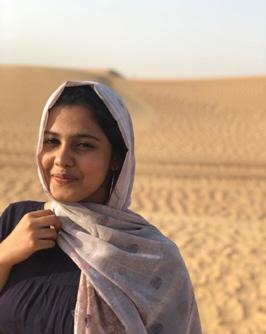
Afrin Falim K
Mohammed
Nihal Kuruppam Thodi Hiba K
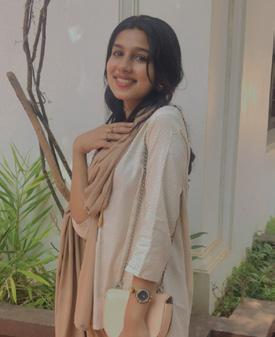


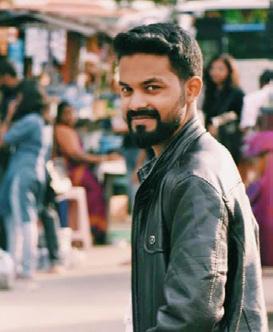
Ayisha Shadha
Reesha Faizal

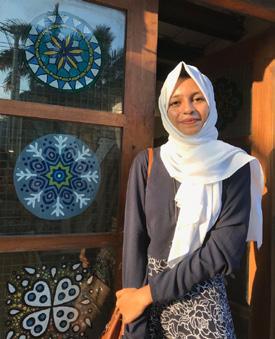
05 35
EASA Participation

It was a moment of pride when Aneez Muhammad of 2018 batch was selected to attent EASA, a sister association of NASA in Europe, representing India, for two consecutive years in EASA Serbia and EASA Romania. He attended the latter online due to the covid restrictions. Following are a few entries done by Aneez during the online sessions :

As we are now preparing for the 64th year Annual NASA Convention, NASA has announced the list of top 21 colleges under Le Corbusier overall trophy ranking. We feel delighted and honored in securing 21st rank from among all the Architecture colleges in India for our efforts in our first year.
All these achievements are sure to be a true inspiration for the students to work for both informal and formal trophies and activities hosted by NASA India.
 Written By : Evelyn Philio Ittoop (Batch 2019)
Written By : Evelyn Philio Ittoop (Batch 2019)

06
36
Aneez Muhammad
Seize the Moment
NASA 2022 - Photography
Competition
Glimmer the picture was a pre-recorded modeling contest that happened as part of 64 th NASA India zonal event 2021-22, Zone 6-FARRAGO, themed “Coalescence in Architecture”, hosted by Hindustan Institute of Technology and Science, Chennai. The topic of the event was ‘Retrograde Fashion’. The event took place online owing to the pandemic and the entries were submitted likewise. The event required concept development, styling and photography, all to be directed by the participant.

The concept was developed over the course of a few days, making use of immediate resources. It was important to not stray away from the topic, yet improvisation and re-interpretation was the key to winning this competition. The concept developed was “Reminiscing some of the timeless elements of Desi retrograde fashion in the era of virtual culture.

Handpicked from the best of both worlds, a momentary escape from realities of both past and present”. The concept was inspired from the shift from face-to-face to virtual culture during the pandemic.
The monotony of our lives online called for a break every now and then.
Through this concept I aimed to put across the idea that, by creative engagement of the mind by designing and reminiscing in a different era of fashion, one finds the perfect escape from the mind breaking schedule during a pandemic.As the concept says, “a momentary escape” is what the engagement in this contest brought me. The design was put together using a traditional sari from the 1920s, paired with pearls and beads of that era.
Accompanying the costume were props like ‘Aranmula kannadi’ an age-old handicraft of Kerala, a tea cup and saucer and a laptop which showed a google meet in progress.Attending a modeling contest online exposed me to challenges like setting up and directing all by myself. It was instrumental in pushing my limits and exploring my capabilities at the same time.
Written by : Mary Ann Mathew (Batch 2020)
07
37
Mary Ann Mathew
Capturing the Moment
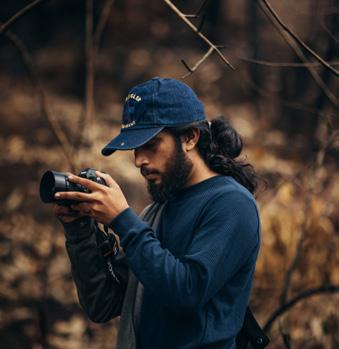
National Institute of Technology, Calicut - Tathva 2022 : Photography Competition
M J
Abhay M J , student of Batch 2019 has bagged the first prize in the photography competition conducted by NIT, Calicut under Tathva 2022. Following is his experience of the same. Is history written by victors? I would complete this question mark with a long no. History is not written by the victors, but by those who put in efforts to do their greatest. To win or to not win, is not what our intention should be.
I believe it is the amount of commitment, hard work and struggle one has put behind it should be the chief precedence,and the rest will follow. First, history isn’t set in stone. When new facts emerge, it gets revisited.
Tathva is the largest tech management fest in South India steered by the NIT, Calicut. I was a part of the photography competition, topic: Chaos. We all know what chaos is. Through this photograph, I wanted to portray how chaos was expressed in real life. As a part of this, I explored the Sakthan market in Thrissur for one complete day. But by the culmination of the day, I failed to accomplish what I looked for.
Then, as a succeeding set of trials, I visited the numerous streets and roadsides within Thrissur trying to bring out the idea of chaos in one’s life, but yet again, seizing what I was looking for was nowhere.
After a lot of experiments and faults I decided to produce a circumstance which depicted chaos. But this wasn’t easy either. I had to put in a lot of time to come up with the right idea.
The picture here,shows a kid with water being splashed on his face and his eyes wide open staring intensely into the lens. The water here was used as an element of disturbance which developed a condition of chaos.

08
38
Abhay
Moving Frames
Abhay M J
This was a shortlisted video by NASA, on the topic: product videography. The idea I put behind this was to emphasize not only on the product but also the play of every element behind it.



The product is not looked in isolation, but the elements used along with it expresses it and gives it a much more connotation to the frame.
Inspired by Peter Mckinnon, I tried to accommodate the play of light. I couldn’t videograph it all by myself as it comprised motions, I had to seek help.
Winner : Abhay M J (Batch 2019) Written by : Radhika Krishnan (Batch 2020)
09
39
NASA 2021 : Product Videography : Shortlisted
Expanding Horizons
Attending National Institute of Technology, Calicut Cultural Fest - Ragam 2022
The cultural fest held by NIT-C, Ragam, is definitely the place to be for college students across India. It is the largest cultural fest held by students in South India and perhaps all of India. Ragam ‘22 happened in the first weekend of May this year and it was happening after missing a year due to the pandemic. We attended Ragam 2020 as first years, but we went as mere spectators who were there to enjoy the concerts.
This time it was different, we had decided to take part and try our hand at the competitions and hopefully come back to college with the wins. We had entries in most of the competitions there both individual as well as groups and even sent two football teams for the sports events. We went with practice for some events and many others as first timers and it was really fun. We had a better time when we participated in events than the time we went just for the concerts.
Winning Entries
Minu Joseph (Batch 2019) secured second place in the events Spelling Bee and What’s the Good Word.
Spelling bee is spelling the words and What’s the good word was a series of word games and as a grammar and spelling nazi most of my life, I really enjoyed these competitions
Mary Ann Mathew (Batch 2020) secured second place in the event ‘JAM’

JAM stands for ‘Just a Minute’. To play ‘Just A Minute’ you must speak for a minute on a given subject. If you hesitate, repeat yourself, or deviate, an opponent will interrupt and take the subject. Points are gained for speaking when the minute is up, correctly interrupting, or being wrongly interrupted.
The event happens in 2 stages. The prelims and finals. The prelims took place with 3 different panels, whose winners moved into the finals. The prelims and finals carried the topics, ‘slip of a tongue, can get you in deep trouble’ and ‘a world without women is insufferable’. Competitors came from colleges all across South India.

Taking part in events like these offer a lot more reward than just the winning prize. It is a chance to gain substantial experience in public speaking, uncover personal aptitude and networking, all of which can contribute to the holistic development of students.
Written by : Mary Ann Mathew (Batch 2020) Minu Joseph (Batch 2019)
10
40
Soutez competition
Sketching Competition - IIA Kerala State Awards
Wafa Abdul Rahman

An onsite sketching done when I visited Dubai in 2021.
A sketch of Al Fahidi Historical Neighbourhood in Al Seef Dubai formerly known as Al Basthakiya which depicts life in Dubai before its modern wealth and development. It is a rich display of the quaint tradition and quiet elegance of the old city. The mud brick and stone fortresses with the wind towers known as BARJEEL has a very distinctive architecture. The planning of the city and its allies including the creek harbor is quite interesting and takes us back to the historical era.

I wanted to express the warmth of the alley ways ,the ambience that the place creates at the time of sunset. As a student architect ,I wanted to explore the different rendering techniques that can be done with a pen to emphasize the texture and details of each object in the surrounding . I was not ready to leave the tiniest of the cracks and crevices on each of the pieces laying around and hence the sketch.
My Entry for Urban Sketching for the competition conducted by Soutez Kerala was shortlisted and had received the certificate of participation during the IIA Kerala State Awards 2021 held at Krishna Beach Resort at Kannur on 6th of May 2022.
Written by : Wafa Rahman (Batch 2020)
11 41
STUDENT ACTIVITIES
Iftar Party
Celebrating Friendship and Compassion
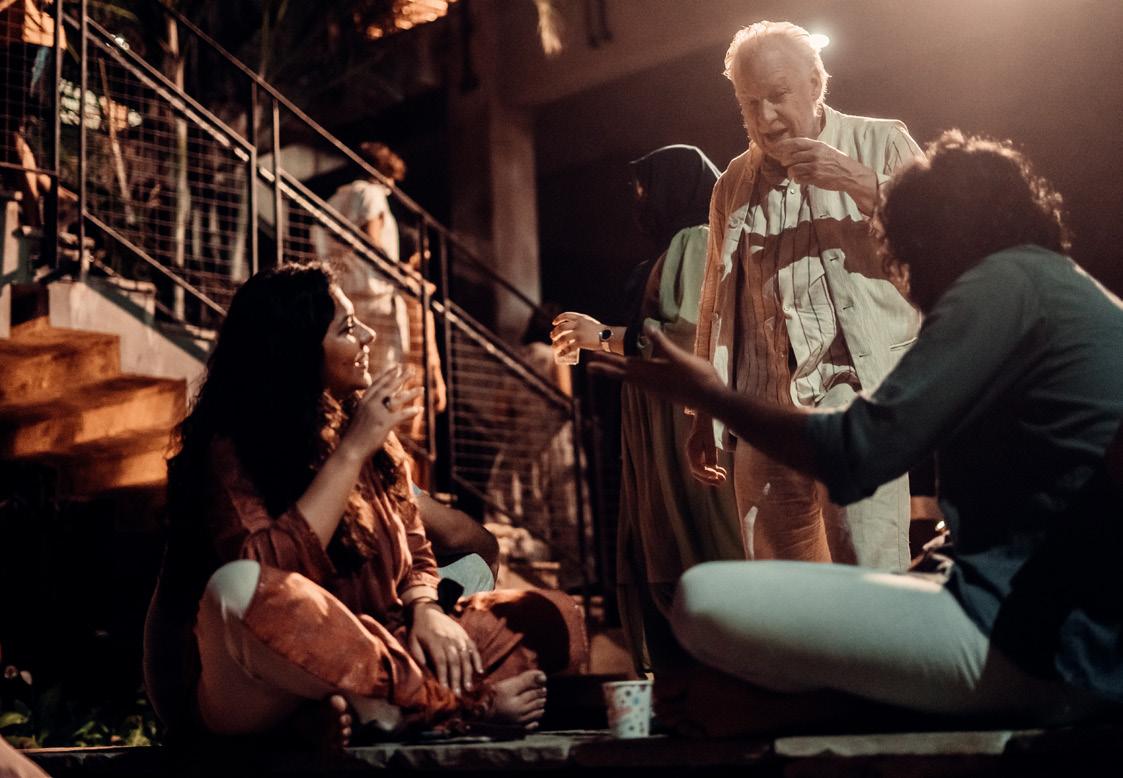
Ramadan is a holy month and a period of introspection for Muslims all over the world. After the sunset prayer, people gather around and break their fast with a meal called iftar.
Ramadan in Kerala, especially in culturally diverse Kozhikode, is about prayers, sharing food, extending relief for the poor and preserving the credentials of communal harmony. It unifies everyone irrespective of religion, caste, etc. This is the only time most of the city’s lights are kept on until dawn and food markets and pavilions fill the streets.
Famous pockets like Mananchira Square, Francis Road and Kuttichira beach come alive with carts and stalls selling a wide range of eatables in the evenings. One can find a huddle of people around the carts and hear the scrunch of pickled goods in the jars. This holy month has been a celebration of food, love, fraternity, charity, and spirituality for all walks of people in the city. Avani culture promotes inclusivity in religion, gender and other such aspects. Many students and staff observe fast during this holy month irrespective of their religious backgrounds.
On 28th April 2022, at the triple height space in our campus, all of us gathered for the Avani iftar meet to share food and good wishes with each other. In addition to it being hosted by the Students Council, the event was a wonderful way for us to connect with one another.
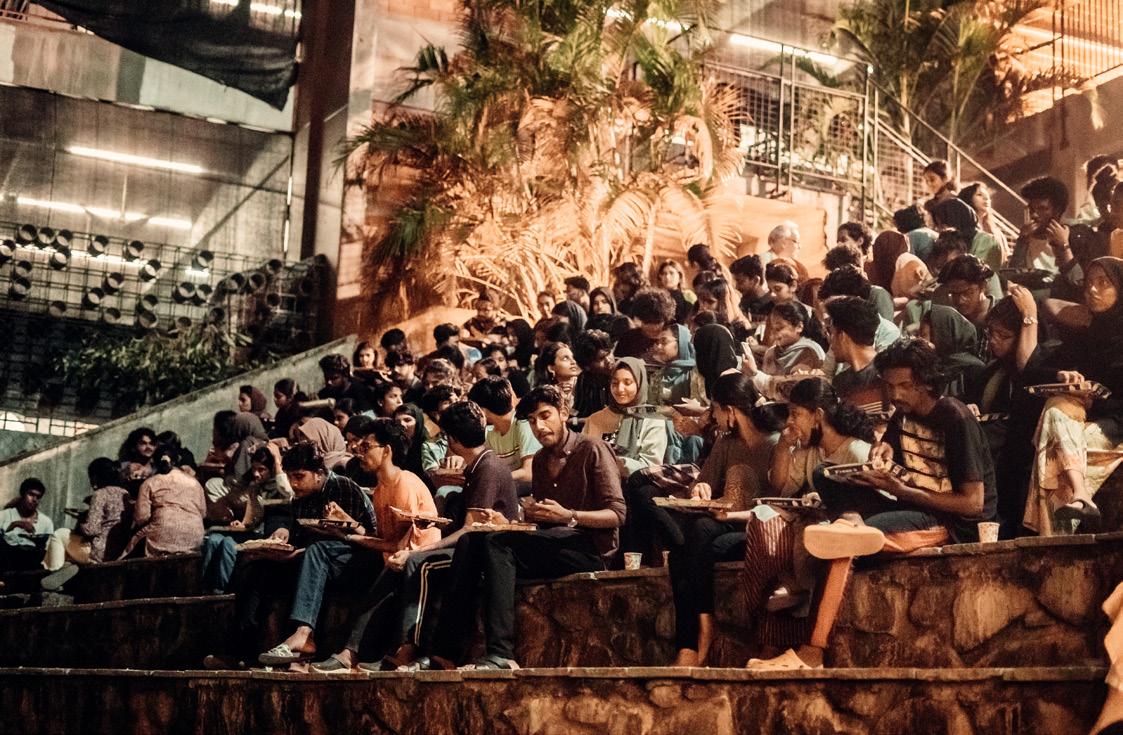 Written By : Haya Abdul Rahman (Batch 2019)
Written By : Haya Abdul Rahman (Batch 2019)
01 42
Going beyond the Hour
Acknowledging Earth Hour 2022


All year around, we spend a lot of time in the company of mother nature, but, what do we do to conserve it?
Earth Hour is a global event that is organized by the World Wildlife Fund for uniting people to come together and take action to protect our mother nature. People from all around the world take part in this drive by turning off their lights and other needless electric appliances.
The WWF slogan says 60+, which means that this practice should not be constrained to just this prearranged time period but instead, they want us to reflect and do beyond that one hour. Earth nurtures life, and it is our responsibility to care for the planet’s well-being. Conservation is obligatory for the betterment of human life on the planet.
In our campus, the cafeteria space was utilized to partake in this global event. The entire college gathered here by pausing their respective duties and the use of electricity. Lighting up the candles, we spent a lot of time reflecting about the ways we could conserve our nature. The Student Council President, posited strategies to bring change within the campus. We sang together to spread light and joy through these sixty minutes.
Written By : Aleen Manjith (Batch 2020)
02 43
Tadbhava
Rejuvenation of the Kiln
Isn’t playing with coloured clay a nostalgic remembrance for you. If not all, I suppose at least for a few out there? The colorful doughs out of which we style out flowers, elephants and what not, takes us back to those youthful days. But with the passage of time, most of us gave up on sculpting the same. Here at Avani, clay is a material that is familiarized to every newcomer. But don’t you want to preserve those statuaries?
Learning about the form, content and meaning using clay, in which every student got to explore the medium and diversity of techniques. The students were all set to start digging up from resting the bricks to construct an internal panel which would lessen the space inside the huge man-made kiln.
Did you know that the practice of terracotta and its baking dated back since the Indus valley civilisations? Isn’t it interesting to learn such traditional techniques from the ancient past? It is so captivating to appreciate how the elements like water, air and fire play a chief role in the baking of the kiln.
Under the strong accountability of artist Usman Pakkath, the rejuvenation of the kiln was taking place after a split of 3 years. This is something that takes place only once in a hole of 3-4 years.His strong purpose towards this creation was the chief milestone behind this countless accomplishment.


Commencement with dusting the environs of the early erected kiln by our seniors, it was a contented moment of digging the mud and carrying those heavy carter’s all the way there. Splish- splash of water all over the mud. Yes! It was all muddled, but that podium was filled with so much energy with no grading between the years and everyone running about enthusiastically to revive the kiln.
Moving to the ultimate stages were more penetrating, with one cluster of peers mixing up the shades and the other brushing it out with various inspiration and imagination of the Warli art.The baking of the kiln was to be done with intense care, as the former stages should not have the flames up.

The key strategy was to generate interest amongst the first year students to engage with clay as a material by engaging them to bake all the mud sculptures present on campus (starting from the Uruvam community project in 2019 to the Fake museum and Ancient structures in 2021-22)
Afterall, the course of taking those baked structures was another fascinating round of recalls and was yet another unforgettable account added to our Avani dairies. Once again, it was the strong unity of the students, faculty coordinators who spent their nights and special mention to artist Usman Pakkath for making this event a huge success.
Written By : Radhika Krishnan (Batch 2020)
03 44
Embracing the Colors
Holi Celebrations 2022

Doesn’t everyone look forward to Holi every year? Playing with colors to dancing to the music to uri adithal and so on. But why do we celebrate Holi? Holi is a festival that holds a lot of significance in the Hindu religion, but people all around the world celebrate this occasion as one. Holi remarks on the arrival of spring and the end of winter. It also marks blossoming love, fun, happiness, forgive, forget and a moment to enjoy with the ones you love.
This year in Avani, Holi was nothing less than mesmerizing. The whole event was organized jointly by the student council and fellow Avanites. Everyone gathered at the grounds behind the Avani residence wearing white clothing to make sure they get to bring back the colored stains of a very memorable day. The colors and the music were mesmerizing kickstarting the Holi celebrations. Students balanced the act of throwing colors at each other while dancing to the beat became picture perfect memories in our phones

The arrival of Nasik dhol made the atmosphere even more exciting and vibrant. The play of fire by the dancers took everyone’s breath away. Uri Adithal is definitely not an easy game but the winners of each batch truly showed what it takes to break the hanging pot. The celebrations lasted an entire evening. Although everyone walked away with wet and stained faces and clothes, 19th March 2022 was truly an unforgettable day for all. It truly brought back the essence of how Avani is and how it has always been. This day has made everyone forget about their worries and a platform to have a whole lot of fun.
Written By : Lavannya K (Batch 2020)
04 45
info@avani.edu.in
Avani Institute of Design, Ambayathode, Koodathai Post, Thamarassery,Calicut, Kerala 673573, India
Credits | Graphics team : Abhay Rajesh, Aiswarya PP, Athira Balakrishnan, Sreechandana S Nair | Content Curation & Editorial : Ar Anjali Sujat, Monish V Kunjumon, Radhika Krishnan| | Critic at large : Dr Soumini Raja











 Written by: Ar Vineeth T K
Written by: Ar Vineeth T K






 Written by: Ar Athira Balakrishnan, Ar Sanjay Veerakumar
Written by: Ar Athira Balakrishnan, Ar Sanjay Veerakumar



























 Written by: Ar Rajiv Babu, Ar Satyajeet Sinha
Written by: Ar Rajiv Babu, Ar Satyajeet Sinha



 Written by: Ar Sebastian Joseph
Written by: Ar Sebastian Joseph


 Written by: Ar William George Kennedy
Written by: Ar William George Kennedy



 Written by: Ar Gisny George Kurian
Written by: Ar Gisny George Kurian

 Written by: Ar Monisha V Kunjumon
Written by: Ar Monisha V Kunjumon















 Written by : Ar William George Kennedy
Written by : Ar William George Kennedy







 Written By : Ar Anjali Sujat
Written By : Ar Anjali Sujat











 Selected Sheet from Entry 1:
Selected Sheet from Entry 1:






















 Written By : Evelyn Philio Ittoop (Batch 2019)
Written By : Evelyn Philio Ittoop (Batch 2019)













 Written By : Haya Abdul Rahman (Batch 2019)
Written By : Haya Abdul Rahman (Batch 2019)






